Gujarat, situated in the western part of India, is a land blessed with a rich variety of flora and fauna. It is home to some of the most beautiful and diverse bird species in the world.
The state boasts of a vast coastal area, wetlands, forest, grasslands and desert, each habitat hosting different varieties of birds. Gujarat’s bird life is of considerable ecological significance, with several species being classified as rare or endangered.
This land of colors is a bird-watcher’s delight, with birds ranging from common backyard birds to migratory birds, exotic species, and wetland birds.
This article will explore the fascinating world of birds in Gujarat, highlighting some of the most interesting and unusual species, and showcase the region’s importance as a birding destination.
1. Painted Stork
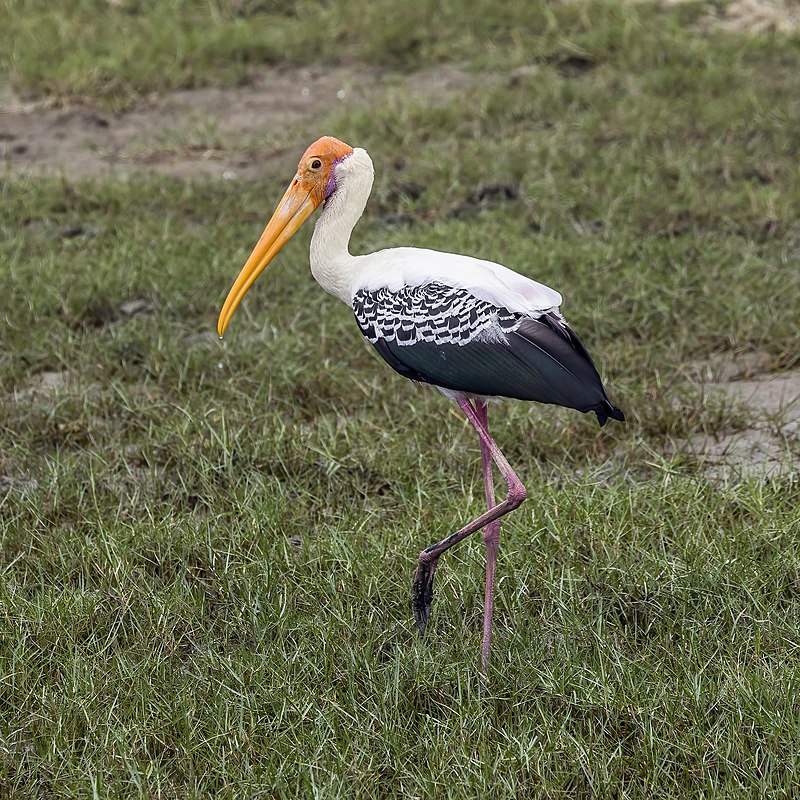
The Painted Stork is a large bird that belongs to the stork family. It has an impressive wingspan and can be found in tropical Asia, ranging from the Indian subcontinent all the way to Southeast Asia.
These birds are unique because of their pink tertial feathers, which gives them their name. They form flocks when they forage in shallow waters near rivers or lakes.
They dip their half-open beaks into water looking for food such as fish, frogs and other small aquatic creatures.
A distinctive feature of these birds is that during breeding season both males and females have red eyes with yellow rings around them.
This species also displays amazing cooperative behaviour when nesting; young storks help build nests by bringing material back to older ones who weave it together forming huge colonies on trees close to wetlands.Scientific classification:
| Kingdom | Animalia |
| Phylum | Chordata |
| Class | Aves |
| Order | Ciconiiformes |
| Family | Ciconiidae |
| Genus | Mycteria |
| Species | M. leucocephala |
Also Featured In: Common Birds in India, Birds that Live in Tamil Nadu
2. Knob-Billed Duck
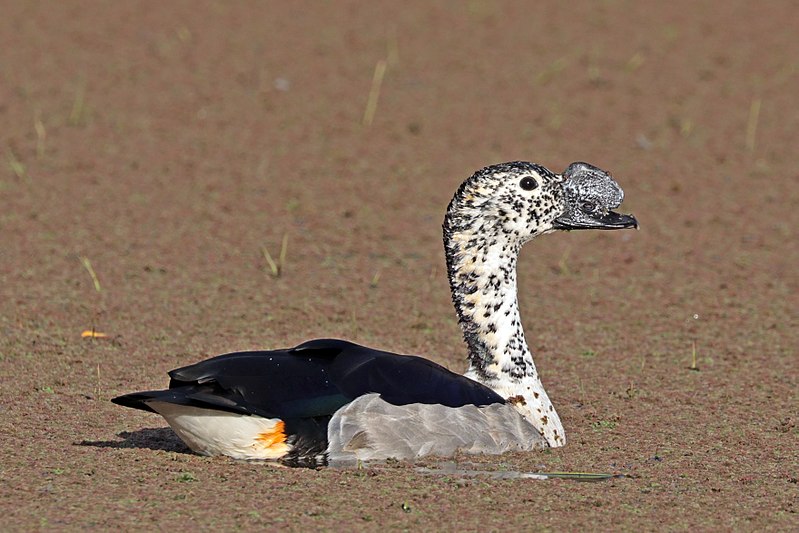
The Knob-billed Duck is a large duck found in tropical wetlands across Sub-Saharan Africa, Madagascar and the Indian Subcontinent.
They have distinctive knobbed bills which makes them easily recognizable amongst other duck species.
Their diet consists of small aquatic creatures such as crustaceans, mollusks, tadpoles and insects.
This bird prefers to nest near water sources like marshes or shallow lakes but can also make its home in flooded fields during the wet season.
The population of this species has declined due to habitat loss from urbanization and pollution caused by human activities.
Conservation efforts are underway to ensure their survival for future generations with protection offered at some national parks within their range countries.Scientific classification:
| Kingdom | Animalia |
| Phylum | Chordata |
| Class | Aves |
| Order | Anseriformes |
| Family | Anatidae |
| Genus | Sarkidiornis |
| Species | S. melanotos |
3. Indian Spot-Billed Duck
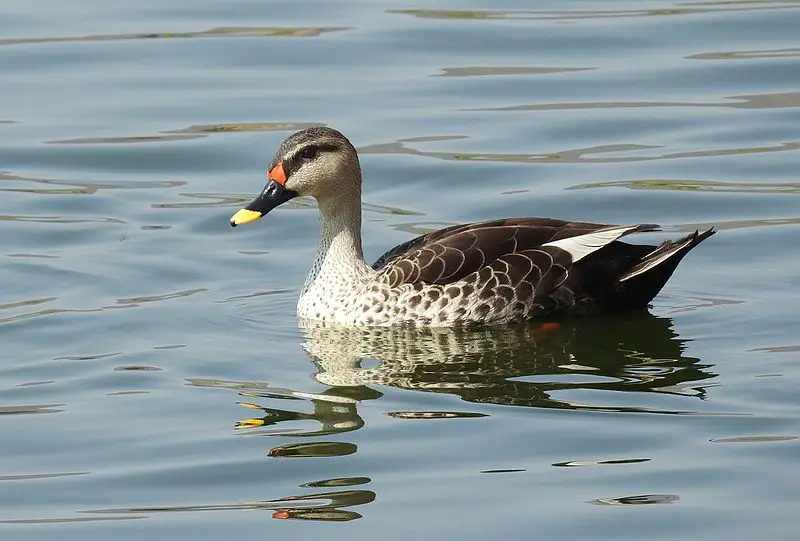
The Indian spot-billed duck is a large dabbling duck found throughout freshwater wetlands in the Indian subcontinent. It gets its name from the red spot at the base of its bill, which is only seen on mainland birds.
Distinctive white tertials form a stripe down their sides, making it easy to recognize them even when far away.
They feed mainly on aquatic vegetation and invertebrates including molluscs and insects but will also consume some grains and fruits during dry seasons or if food becomes scarce.
When not breeding they can be found in flocks with other ducks such as teals or pochards.
Breeding season varies by region but typically takes place between March–May, where pairs build nests close to water usually among reeds or grasses lining ponds, marshes, rivers etc..
The female incubates her eggs for around 24 days before hatching occurs; afterwards both parents care for their young until they fledge after 45-50 days old.Scientific classification:
| Kingdom | Animalia |
| Phylum | Chordata |
| Class | Aves |
| Order | Anseriformes |
| Family | Anatidae |
| Genus | Anas |
| Species | A. poecilorhyncha |
Also Featured In: Native Pakistani Birds, Birds that Migrate to Sri Lankan
4. Indian Grey Hornbill
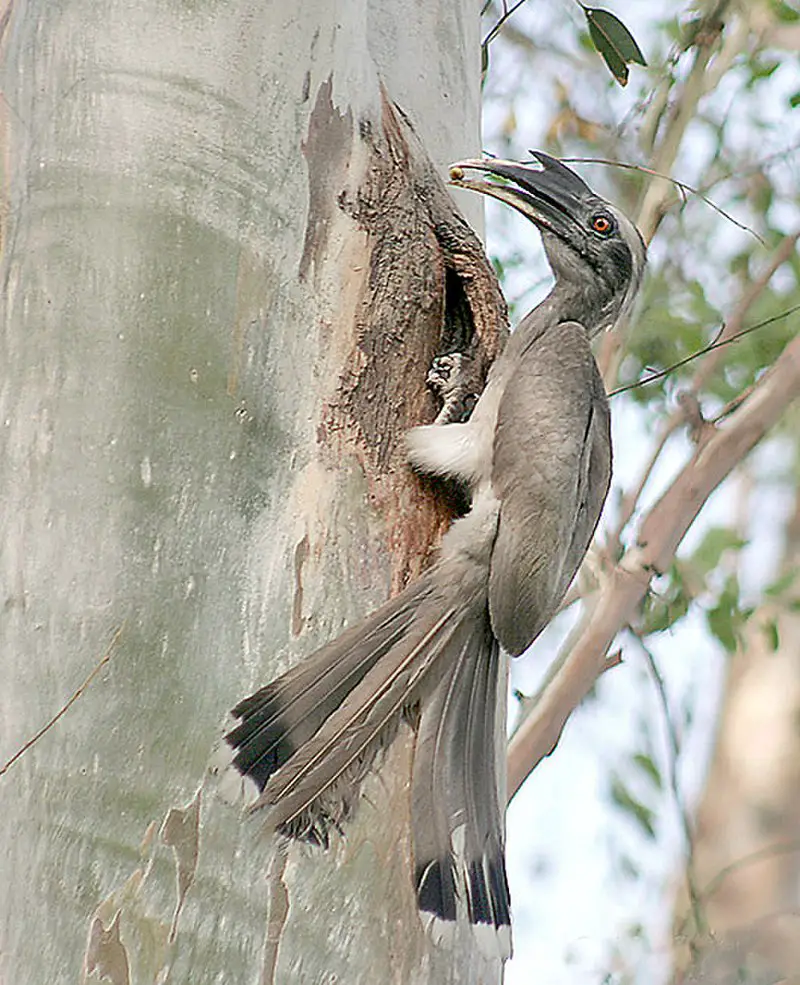
The Indian gray hornbill is a common bird found throughout the Indian subcontinent. It has grey feathers covering its body and a light grey or dull white belly.
Its distinctive feature is an iconic black or darkly-colored horn with a casque extending to the point of curvature on top of it’s head.
They are mostly arboreal, often seen in pairs, and can even be spotted in urban areas across India.
The diet consists mainly of fruit such as figs along with seeds, small reptiles and insects too.
Their loud calls help them communicate over long distances making them easily identifiable within their habitat rangeScientific classification:
| Kingdom | Animalia |
| Phylum | Chordata |
| Class | Aves |
| Order | Bucerotiformes |
| Family | Bucerotidae |
| Genus | Ocyceros |
| Species | O. birostris |
5. Indian Pond Heron
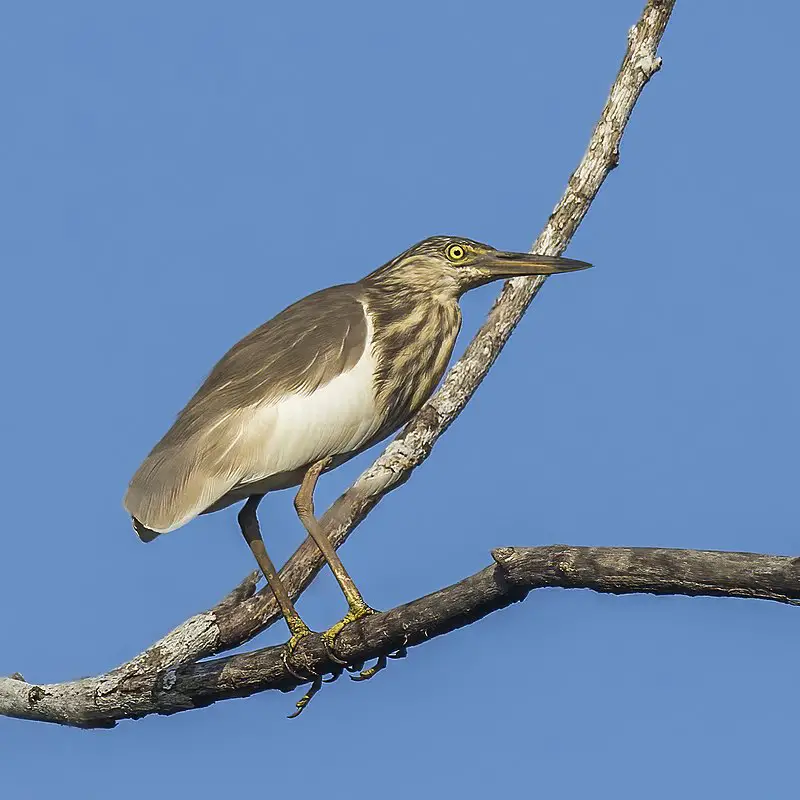
The Indian Pond Heron, also called Paddybird is a small heron found in the Old World. It breeds from southern Iran to India, Burma and Sri Lanka and can be seen near waterbodies or even around human habitations.
These birds are easily recognisable when they take off as their wings make a loud whistling sound due to its long flight feathers which are greyish-brown with white patches on them.
They feed mainly on fish but will eat other aquatic creatures such as frogs and insects too.
During breeding season they construct nests made of reeds close to water bodies where they lay 3–5 eggs at once.
The female incubates the eggs for about 19 days after which both parents share duties of feeding chicks until juveniles become independent enough to fly away.Scientific classification:
| Kingdom | Animalia |
| Phylum | Chordata |
| Class | Aves |
| Order | Pelecaniformes |
| Family | Ardeidae |
| Genus | Ardeola |
| Species | A. grayii |
Also Featured In: Birds of Islamabad, Birds That Live In Phuket Island
6. Common Babbler
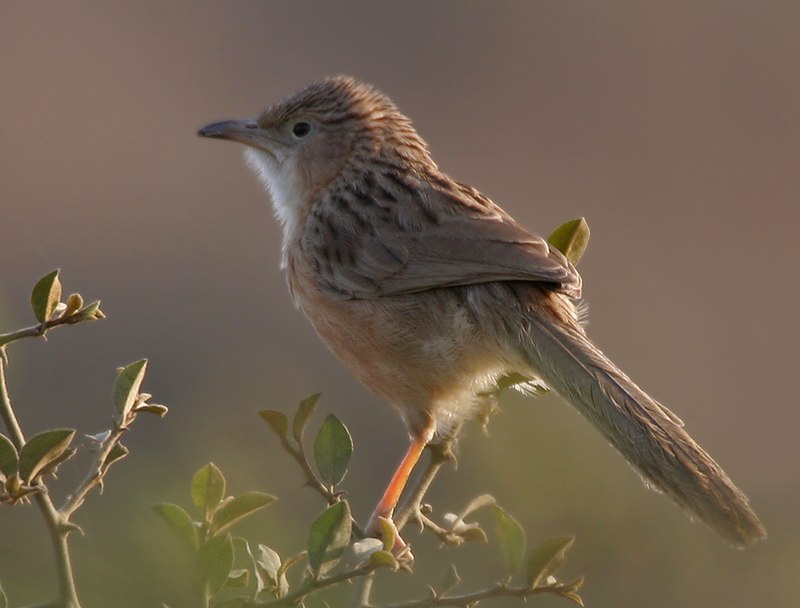
The Common Babbler is a medium-sized, brown bird with an unmistakable long tail. Found mainly in India and parts of Afghanistan, it prefers dry open scrub country near grasslands or cultivation fields.
This unique species has two distinct subspecies; the population to the west of Indus river system are now generally treated as separate species – Afghan Babblers (Turdoides huttoni).
These birds live in pairs or small family groups and can often be seen perched on branches looking for food using their sharp eyesight.
They feed mainly on insects but will sometimes eat berries too.
Despite being relatively common throughout its range this shy creature remains difficult to spot due to its cryptically colored plumage that helps camouflage itself from potential predators.Scientific classification:
| Kingdom | Animalia |
| Phylum | Chordata |
| Class | Aves |
| Order | Passeriformes |
| Family | Leiothrichidae |
| Genus | Argya |
| Species | A. caudata |
7. Collared Pratincole
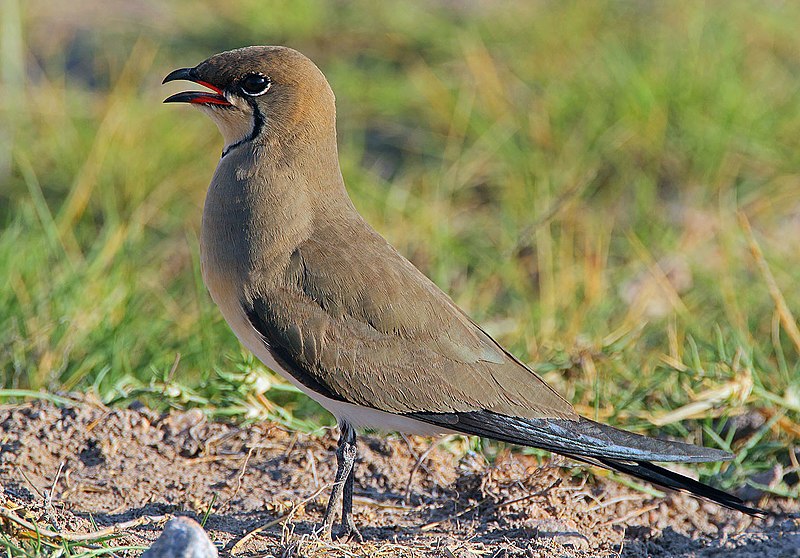
The Collared Pratincole is a small wader bird native to the Old World. It has distinctive long wings that are reddish-brown in color and have white tips, which give it its name.
Its body is mostly dark brown with some lighter spots along its back and sides. The bill of this species is short and pointed, making it a specialist for eating insects from mudflats or shallow waters.
During breeding season, they form loud flocks that can be heard from miles away when calling out their distinct song; during non-breeding time they disperse into smaller groups while searching for food sources in drier regions such as grasslands or fields.
This species relies heavily on open habitats where there are plenty of places to hunt for food throughout the year.Scientific classification:
| Kingdom | Animalia |
| Phylum | Chordata |
| Class | Aves |
| Order | Charadriiformes |
| Family | Glareolidae |
| Genus | Glareola |
| Species | G. pratincola |
Also Featured In: Beautiful Brazilian Birds, Birds That Live in Iraq
8. Large-Billed Crow
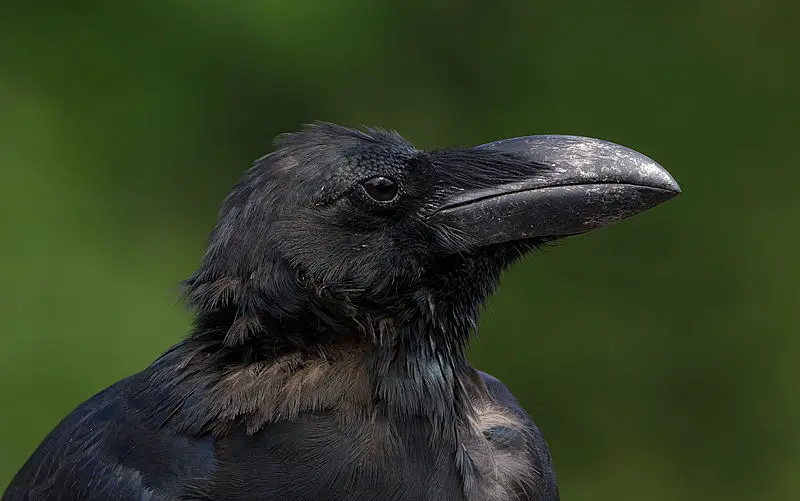
The Large-billed Crow, also known as Jungle Crow, is a species of crow found throughout Asia. It has adapted to many different food sources and can easily colonize new areas due to its resilience.
This makes it an unwelcome presence in some places, particularly islands where the bird’s numbers can quickly get out of control.
The name macrorhynchos comes from its large bill which sets it apart from other crows living in the same area; this bill helps them break open hard shells or tough skinned fruits with ease.
They have glossy black feathers over their bodies and yellow eyes that make them look very imposing when seen up close.Scientific classification:
| Kingdom | Animalia |
| Phylum | Chordata |
| Class | Aves |
| Order | Passeriformes |
| Family | Corvidae |
| Genus | Corvus |
| Species | C. macrorhynchos |
Also Featured In: Common Birds in Japan, Tokyo Birds You Need to Know
9. Egyptian Vulture
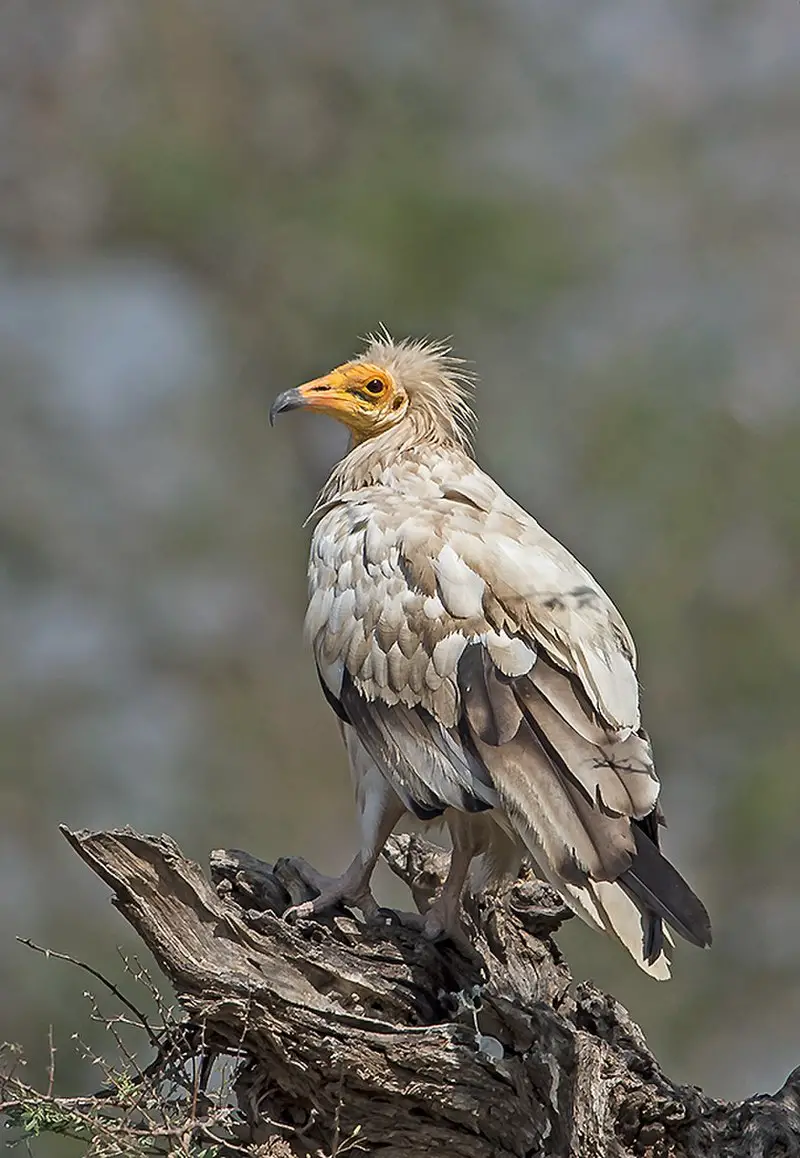
The Egyptian Vulture is a small Old World vulture known for its distinctive wedge-shaped tail and contrasting underwing pattern.
It has been found from the Iberian Peninsula through North Africa to India, making it one of the most widespread birds in that area.
This species eats mostly carrion but will also feed on eggs and small prey if they can find them. Its diet consists mainly of lizards, insects and other invertebrates as well as fruit like figs, grapes or mulberries when available.
The Egyptian Vulture plays an important role in ecosystems by helping to clean up carcasses which could otherwise spread disease or attract predators such as jackals into human settlements.
They are considered vulnerable due to threats including habitat destruction, electrocution from power lines and accidental poisoning – all factors contributing towards their decline in numbers across their rangeScientific classification:
| Kingdom | Animalia |
| Phylum | Chordata |
| Class | Aves |
| Order | Accipitriformes |
| Family | Accipitridae |
| Genus | Neophron Savigny, 1809 |
| Species | N. percnopterus |
Also Featured In: Egyptian Birds, Birds You’ll Find in Albania
10. Common Chiffchaff
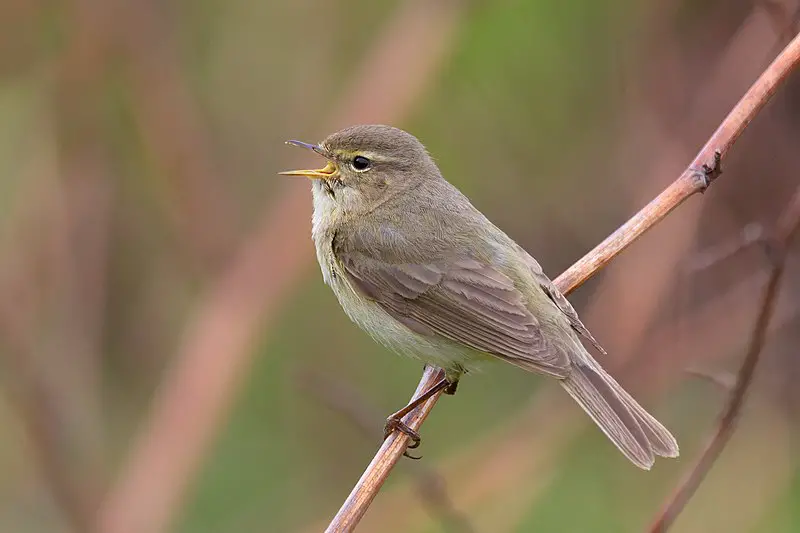
The Common Chiffchaff is a small bird found in northern and temperate Europe and the Palearctic.
It has greenish-brown plumage on its upper parts, off-white feathers beneath, and gets its name from an onomatopoeic call that resembles “chiff chaff”.
This migratory passerine breeds in open woodlands during summer before heading to southern Asia, western Europe and North Africa for winter.
A frequent visitor at gardens with good insect supplies, it feeds mainly on insects such as flies, beetles or ants which are caught by gleaning foliage or hawking aerial prey.
Despite being one of Britain’s most common birds – estimated numbers between 6–9 million pairs – their population numbers have declined over recent years due to habitat destruction caused by climate change.Scientific classification:
| Kingdom | Animalia |
| Phylum | Chordata |
| Class | Aves |
| Order | Passeriformes |
| Family | Phylloscopidae |
| Genus | Phylloscopus |
| Species | P. collybita |
Also Featured In: Birds of United Kingdom, Most Common Songs Birds that Live around You
11. Greater Flamingo
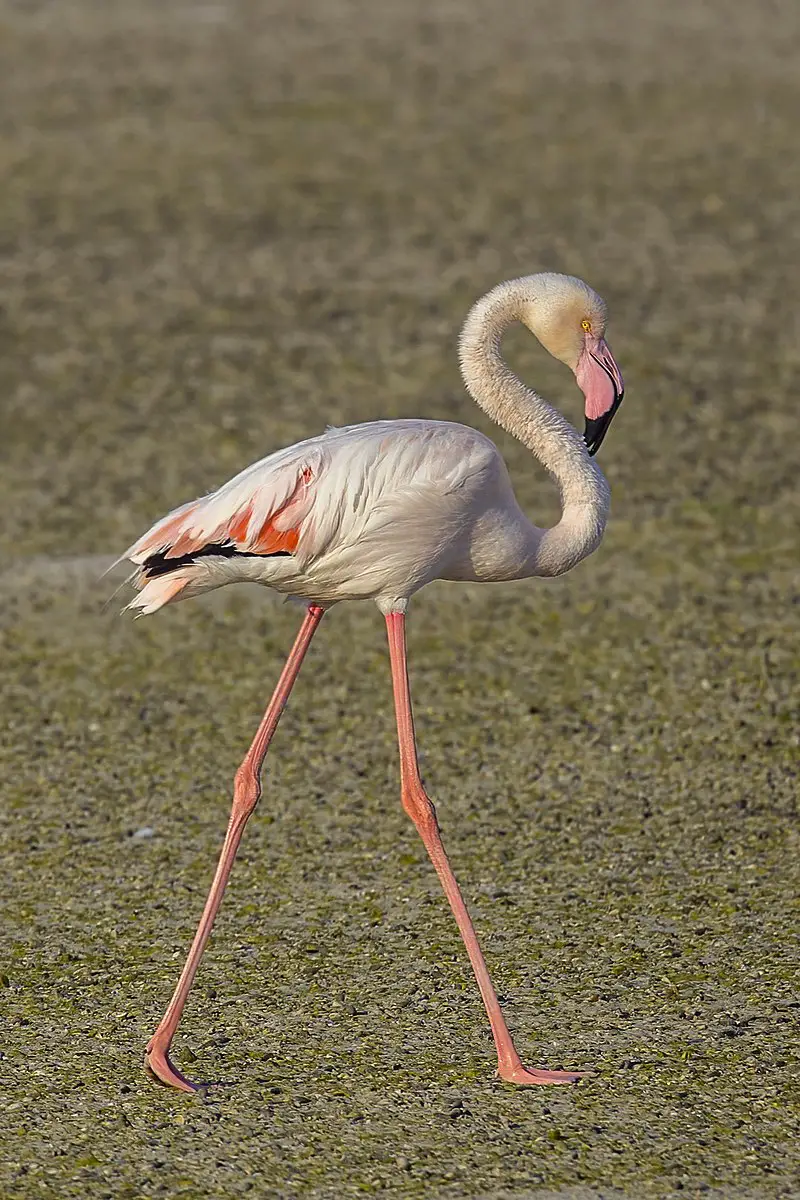
The Greater Flamingo is an impressive bird belonging to the Phoenicopteridae family. It’s one of the most widespread and largest species among flamingos with a range covering Africa, India, Middle East and southern parts of Europe.
The bird was described by Peter Simon Pallas in 1811 but it wasn’t until recently that it was distinguished from American Flamingo (Phoenicopterus ruber), due to differences in coloration between them.
This large-bodied wading bird stands tall at 1m on average and has bright pink plumage adorning its long neck and legs which gives way to black wing tips when flying.
Its diet mainly consists of algae, crustaceans as well as small aquatic animals like mollusks found while they feed along shallow lakes or lagoons where they live their social lives surrounded by others just like them.Scientific classification:
| Kingdom | Animalia |
| Phylum | Chordata |
| Class | Aves |
| Order | Phoenicopteriformes |
| Family | Phoenicopteridae |
| Genus | Phoenicopterus |
| Species | P. roseus |
Also Featured In: Most common Birds in France, Lebanon Birds Live in Semi-Desert Areas
12. White-Rumped Vulture
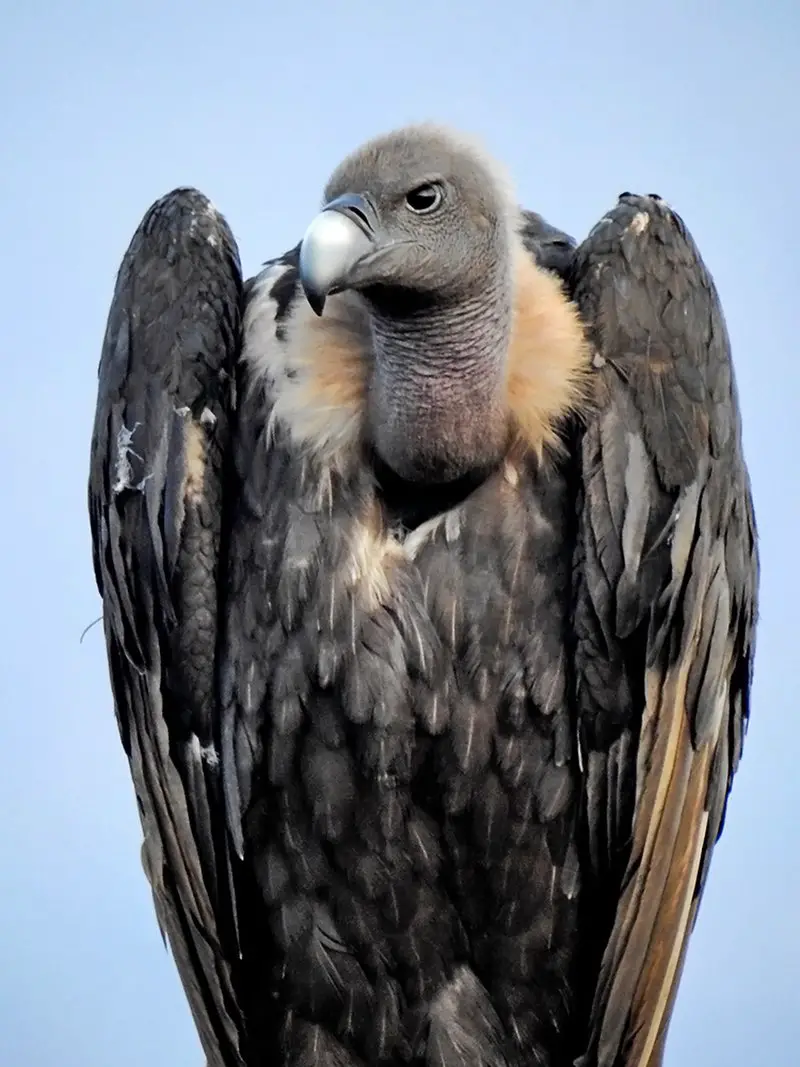
The white-rumped vulture is an Old World species found mainly in South and Southeast Asia. Sadly, it has been listed as Critically Endangered by the IUCN Red List since 2000 due to a severe decline in its population numbers.
The cause of this rapid drop is diclofenac poisoning which leads to kidney failure for these birds.
In the 1980s there were estimated to be several million individuals, but now their numbers have dropped drastically with some experts estimating them at fewer than 10 thousand breeding pairs left today.
Conservation efforts are underway across numerous countries to help save this unique species from extinction and raise awareness about the dangers posed by diclofenac pollution on wildlife populations around the world.Scientific classification:
| Kingdom | Animalia |
| Phylum | Chordata |
| Class | Aves |
| Order | Accipitriformes |
| Family | Accipitridae |
| Genus | Gyps |
| Species | G. bengalensis |
Also Featured In: Birds of Cambodia, Scavengers Birds You Should Know
13. Siberian Stonechat
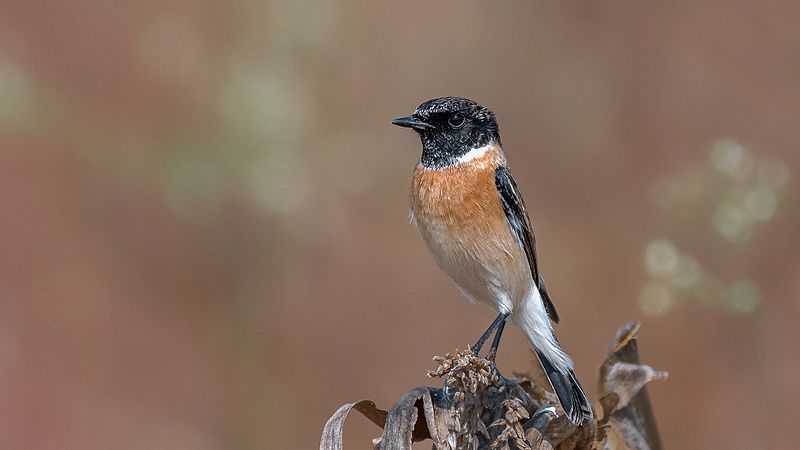
The Siberian stonechat is a species of small bird in the Old World flycatcher family. It can be found breeding across eastern Europe and parts of East Palearctic, while it winters mainly in the tropics.
In terms of appearance, this species closely resembles its closest relative – the European stonechat.
The male has an orange head with a black back and wings, whereas females are more brownish overall but still have some hints of reddish orange on their heads.
These birds feed mostly on insects which they catch by flying after them or picking from vegetation or surfaces near water bodies such as lakes and ponds.
They also eat berries when available throughout summer months to supplement their diet further.Scientific classification:
| Kingdom | Animalia |
| Phylum | Chordata |
| Class | Aves |
| Order | Passeriformes |
| Family | Muscicapidae |
| Genus | Saxicola |
| Species | S. maurus |
Also Featured In: Birds of United Arab Emirates, Birds that Live in Faroe Islands
14. Isabelline Shrike
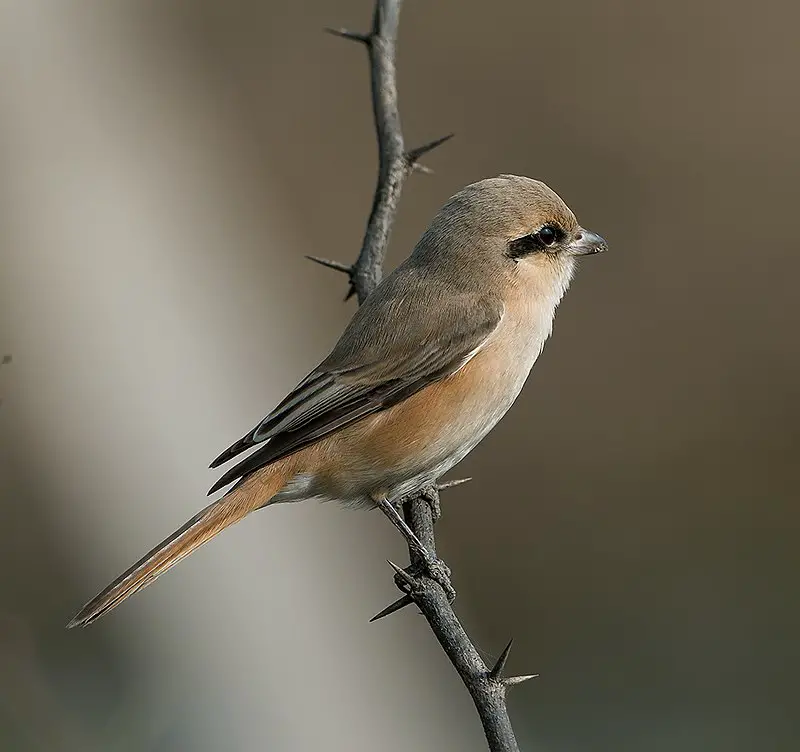
The Isabelline Shrike is a member of the shrike family, Laniidae, and was previously thought to be congeneric with the Red-backed or Red-tailed Shrikes.
It has an extensive range across many countries from Caspian Sea in Western Asia all the way eastward up to Central China’s Qaidam Basin.
During winter months it migrates southwards towards Africa and Arabia for warmer climates.
Its genus name ‘Lanius’ is derived from Latin meaning “butcher”, as its diet consists mainly of small insects and sometimes even lizards or sparrows.
The Isabelline Shrike can easily be identified by its brownish grey coloration along with black wings having white wingtips plus two white bars on each side of their tail feathers.Scientific classification:
| Kingdom | Animalia |
| Phylum | Chordata |
| Class | Aves |
| Order | Passeriformes |
| Family | Laniidae |
| Genus | Lanius |
| Species | L. isabellinus |
Also Featured In: Common Algerian Birds , Common Uzbekistan Birds
15. Black-Naped Monarch
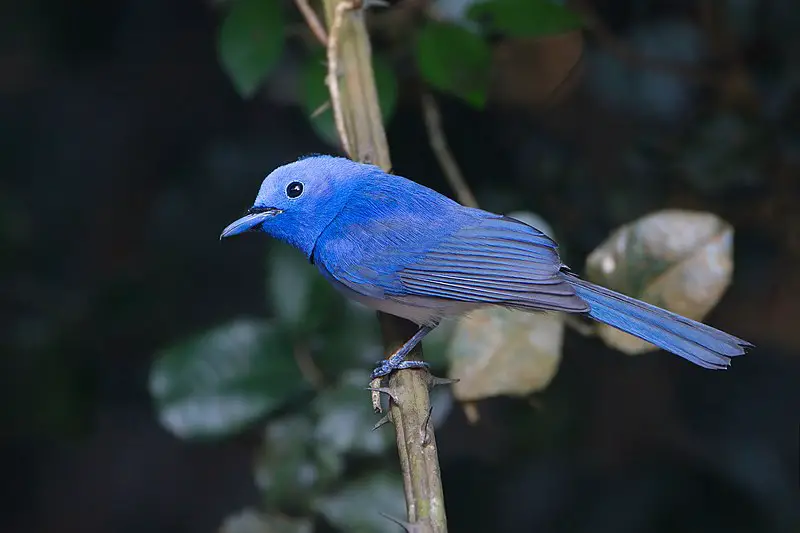
The Black-naped Monarch is a beautiful and agile passerine bird native to Southern and South East Asia.
With its distinct black patch on the back of it’s head, this small but strong species stands out among other birds in the area.
The male has vibrant blue plumage with an elegant narrow black half collar (“necklace”) which makes him even more attractive.
Females are comparatively duller with olive brown wings and light yellowish underparts which helps them blend into their environment better for camouflage purposes.
These birds feed mainly on insects, spiders and fruits making them beneficial as they help reduce pests while also providing nutrients to local vegetation by dispersing seeds from fruit consumption.Scientific classification:
| Kingdom | Animalia |
| Phylum | Chordata |
| Class | Aves |
| Order | Passeriformes |
| Family | Monarchidae |
| Genus | Hypothymis |
| Species | H. azurea |
Also Featured In: Singapore Birds, Most Common Taiwan Birds
16. Common Iora
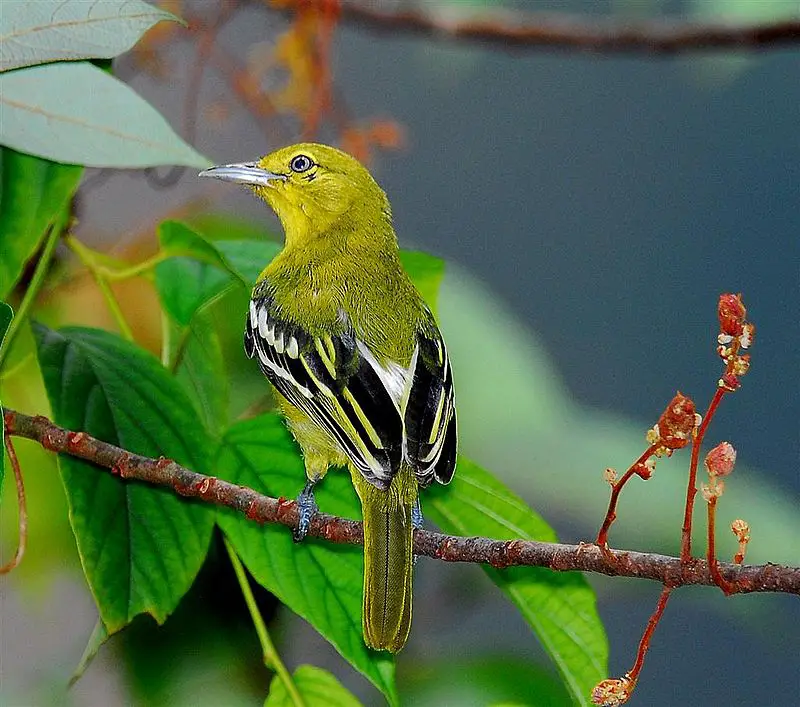
The Common Iora is a bright, small songbird that can be found in the tropical regions of India and Southeast Asia. It has distinctive loud whistles which help to identify it among other passerines.
Its plumage varies depending on where it lives, with some populations having different subspecies-specific colours.
During breeding season males display their feathers by fluffing them up and singing loudly to attract potential mates; females are mostly drabber coloured than the males but still have striking features such as yellow or green wings and tail feathers.
The common iora feeds mainly on insects, using its long bill bent at an angle near its tip to probe for food inside trees’ bark crevices or even into flowers while hovering mid-air.
This bird is usually seen in scrublands and forests but can also sometimes be spotted around urban areas too like parks or gardensScientific classification:
| Kingdom | Animalia |
| Phylum | Chordata |
| Class | Aves |
| Order | Passeriformes |
| Family | Aegithinidae |
| Genus | Aegithina |
| Species | A. tiphia |
Also Featured In: Birds that Commonly Found in Bali,
17. Chestnut-Bellied Sandgrouse
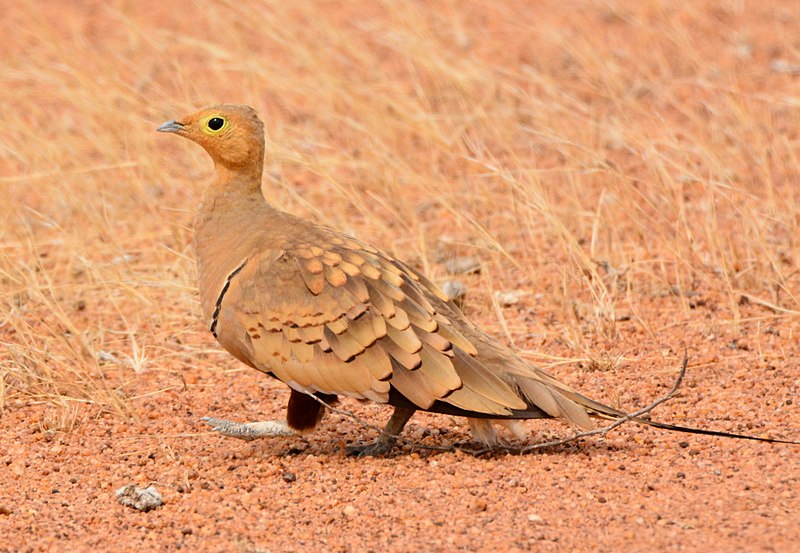
The Chestnut-bellied sandgrouse is a species of bird found in northern and central Africa, as well as western and southern Asia.
It has six recognised subspecies which differ in plumage colouration; males typically have mostly light buffy brown feathers with darker bars on the wings, while females are greyer with paler head markings.
These birds prefer semi-arid regions such as deserts or grasslands where they eat seeds from plants like grasses, herbs and shrubs.
They can be nomadic depending on food availability but tend to be sedentary during mating season when they form small groups called leks for courtship displays involving intricate feather ruffling and strutting around potential mates.
The Chestnut-bellied Sandgrouse is an important part of its native ecosystems due to their role in dispersing plant seeds over large areas through defecating them after ingestion.Scientific classification:
| Kingdom | Animalia |
| Phylum | Chordata |
| Class | Aves |
| Order | Pterocliformes |
| Family | Pteroclidae |
| Genus | Pterocles |
| Species | P. exustus |
Also Featured In: Oman Birds, Hawaii Big Island Birds You Should Know
18. Laggar Falcon
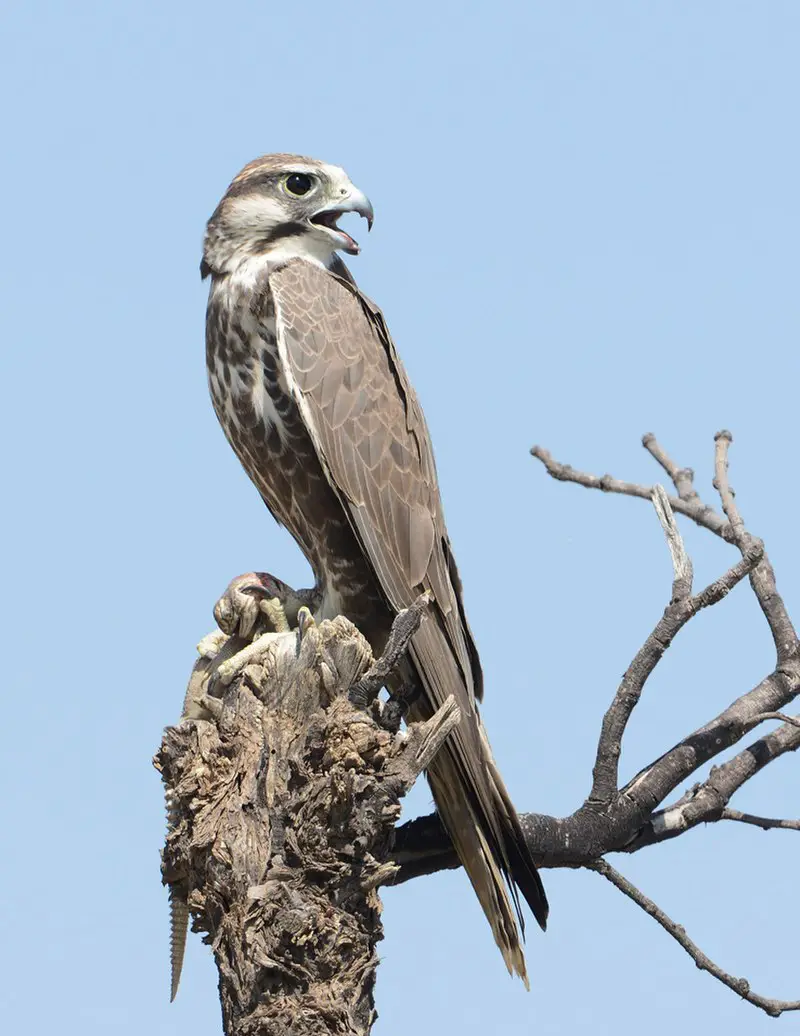
The Laggar falcon is a bird of prey found in the Indian subcontinent. It has an overall dark colouration, with blackish “trousers”, and closely resembles the Lanner Falcon.
Its range stretches from southeastern Iran to northwestern Myanmar, including Pakistan, India, Nepal, Bhutan and Bangladesh.
These birds are usually seen soaring high above their preferred habitats: open grasslands or scrubby forests that provide them access to small mammals such as hares and rodents which they hunt for food.
They mostly feed on carrion but also take birds up to the size of pigeons or doves when active hunting opportunities arise.
Their conservation status is listed by IUCN as Least Concern due to its wide distribution across multiple countries within South AsiaScientific classification:
| Kingdom | Animalia |
| Phylum | Chordata |
| Class | Aves |
| Order | Falconiformes |
| Family | Falconidae |
| Genus | Falco |
| Subgenus | Hierofalco |
| Species | F. jugger |
Also Featured In: Falcons Species, Birds that Live in Rajasthan
19. Yellow-Eyed Babbler
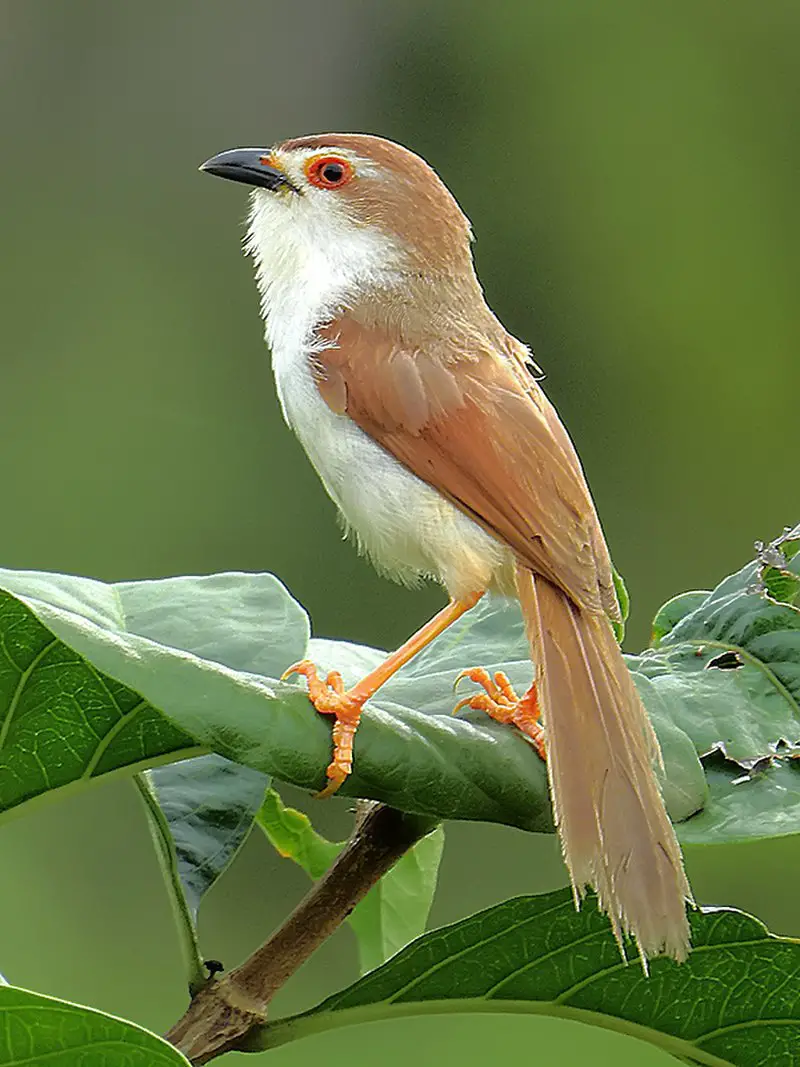
The yellow-eyed babbler is a passerine bird found in South and Southeast Asia. It typically lives in shrubland, grassland, and wetland habitats.
Despite being listed on the IUCN Red List as Least Concern, it is a cherished bird among birdwatchers.
It is known for its distinctive yellow eyes which have earned it its name. Yellow-eyed babblers are part of the Old World babbler family, and their stable population is attributed to their wide distribution.
Overall, the yellow-eyed babbler is a fascinating bird species that can teach us a lot about bird behavior and ecology.Scientific classification:
| Kingdom | Animalia |
| Phylum | Chordata |
| Class | Aves |
| Order | Passeriformes |
| Family | Paradoxornithidae |
| Genus | Chrysomma |
| Species | C. sinense |
Also Featured In: Delhi Birds You Need to See, Common Birds in Bangalore
20. Jungle Prinia
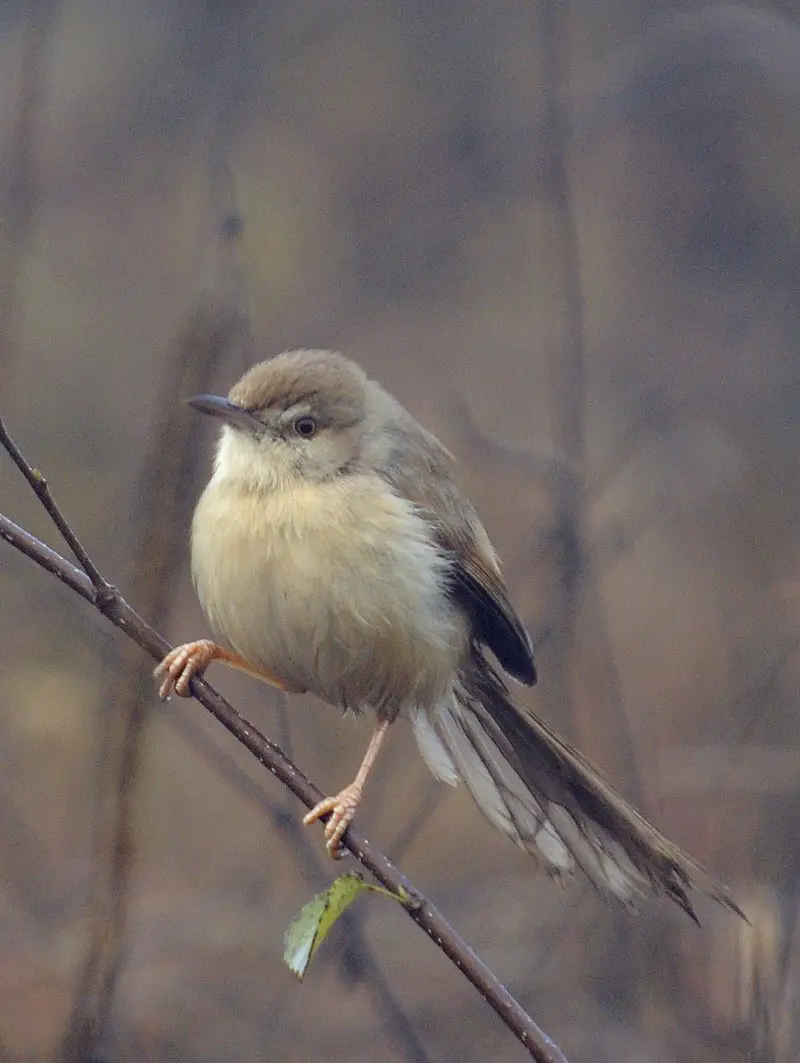
The Jungle Prinia is a small warbler bird from the Cisticolidae family that can be found in India, Bangladesh, southwestern Nepal, and Sri Lanka.
It is usually seen in dry, open grasslands and woodlands, as well as in gardens and scrub areas.
This bird has a short, black bill, strong legs, and short, rounded wings, as well as a longish tail. Jungle Prinias are usually around 15 cm long.
As a resident breeder in the regions where it is found, this bird is known for building nests in shrubs or low trees.
Its coloring is mainly brown, with a greyish underbelly. It is usually seen alone or in small groups and is known for its sweet, melodic song.Scientific classification:
| Kingdom | Animalia |
| Phylum | Chordata |
| Class | Aves |
| Order | Passeriformes |
| Family | Cisticolidae |
| Genus | Prinia |
| Species | P. sylvatica |
Also Featured In: Birds That Live in the Jungle,
21. Greater Spotted Eagle
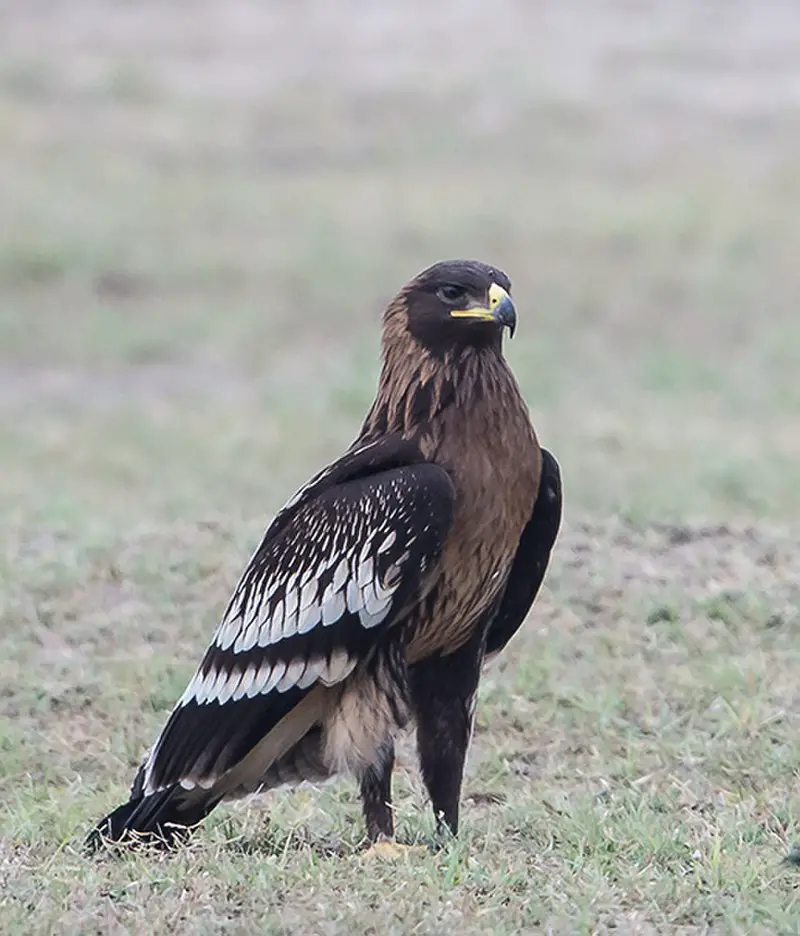
The greater spotted eagle is a large bird of prey that belongs to the Accipitridae family. It is also known as the spotted eagle and has feathered legs that indicate its membership in the subfamily Aquilinae, also called the “booted eagles.”
Although previously considered a member of the Aquila genus, it has been recently reclassified in the Clanga genus, along with other eagle species.
The greater spotted eagle is a magnificent bird with a wingspan of up to 2 meters and is known for its hunting skills.
Due to habitat loss and degradation, its population has been declining, leading it to be classified as a vulnerable species on the IUCN Red List.
Conservation efforts are needed to ensure the survival and protection of this majestic bird.Scientific classification:
| Kingdom | Animalia |
| Phylum | Chordata |
| Class | Aves |
| Order | Accipitriformes |
| Family | Accipitridae |
| Genus | Clanga |
| Species | C. clanga |
Also Featured In: Syrian Birds You Need to Know, Belarus Birds You Should Know
22. Jungle Owlet
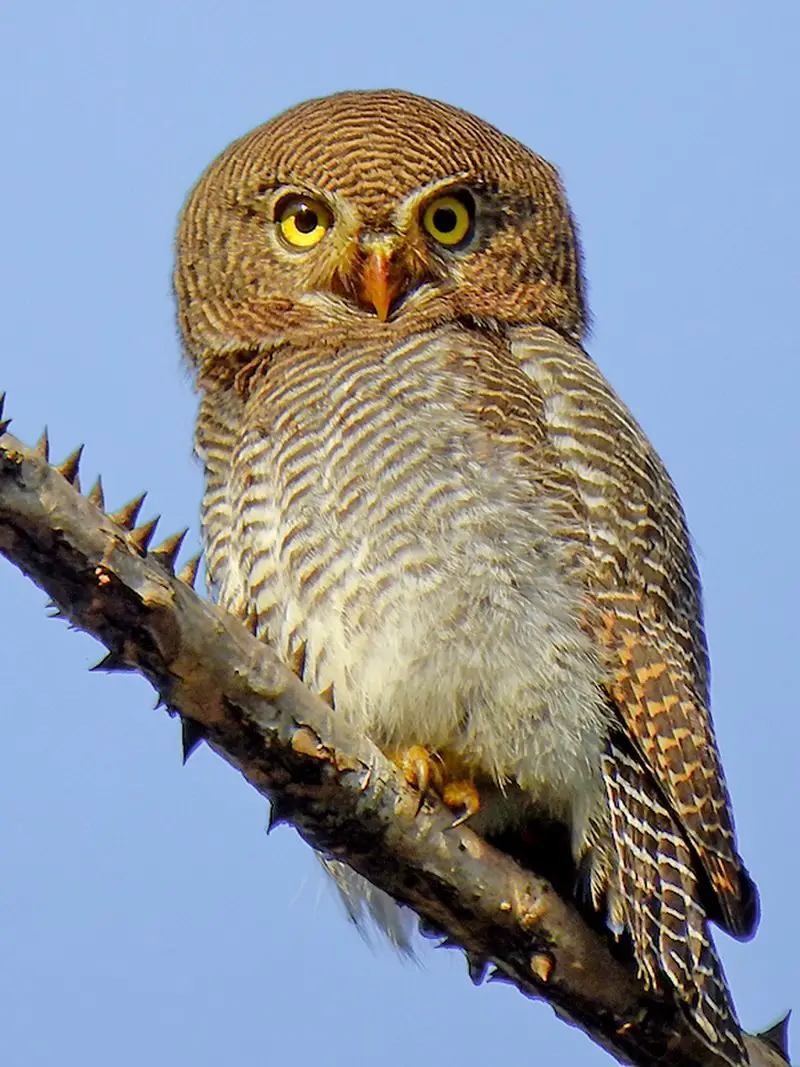
The jungle owlet is a small bird that is native to the Indian Subcontinent. It is also known as the barred jungle owlet and is often found alone or in small groups.
Their calls are heard at dawn and dusk. There are two subspecies of the jungle owlet, with the one found in the Western Ghats potentially being a separate species. They have a rounded head and are finely barred all over.Scientific classification:
| Kingdom | Animalia |
| Phylum | Chordata |
| Class | Aves |
| Order | Strigiformes |
| Family | Strigidae |
| Genus | Glaucidium |
| Species | G. radiatum |
Also Featured In: Birds of Goa, Common Birds in Kerala
23. Yellow-Throated Sparrow
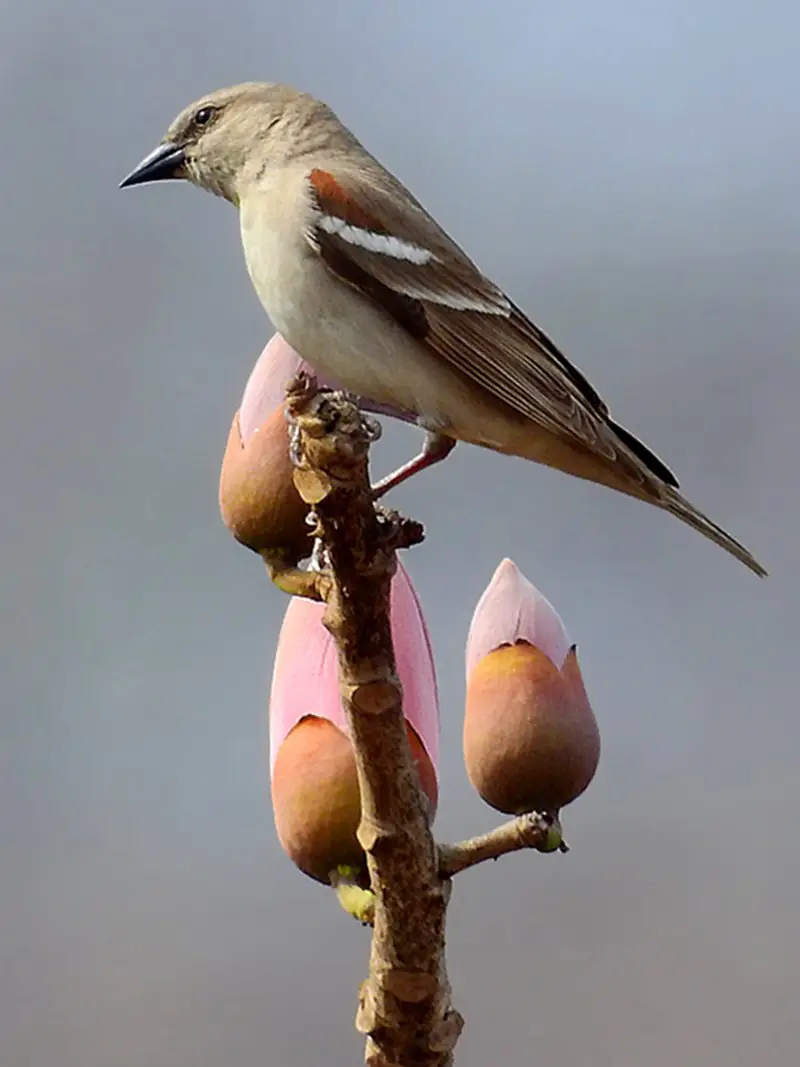
The Yellow-throated sparrow is a small bird that can be found in areas of southern Asia. It is easily distinguishable from other sparrows due to the lack of streaks on its plumage and a white double wing bar on its shoulder.
The male of the species can be identified by a chestnut shoulder patch, though this is not always present. This sparrow has a fine bill that sets it apart from other Passer sparrows.
Its tame nature and ability to adapt to a variety of environments makes it a commonly seen bird in many parts of its range.
While it may not stand out in terms of coloration or markings, the Yellow-throated sparrow is a fascinating and unique bird that is worth taking the time to observe.Scientific classification:
| Kingdom | Animalia |
| Phylum | Chordata |
| Class | Aves |
| Order | Passeriformes |
| Family | Passeridae |
| Genus | Gymnoris |
| Species | G. xanthocollis |
24. Clamorous Reed Warbler
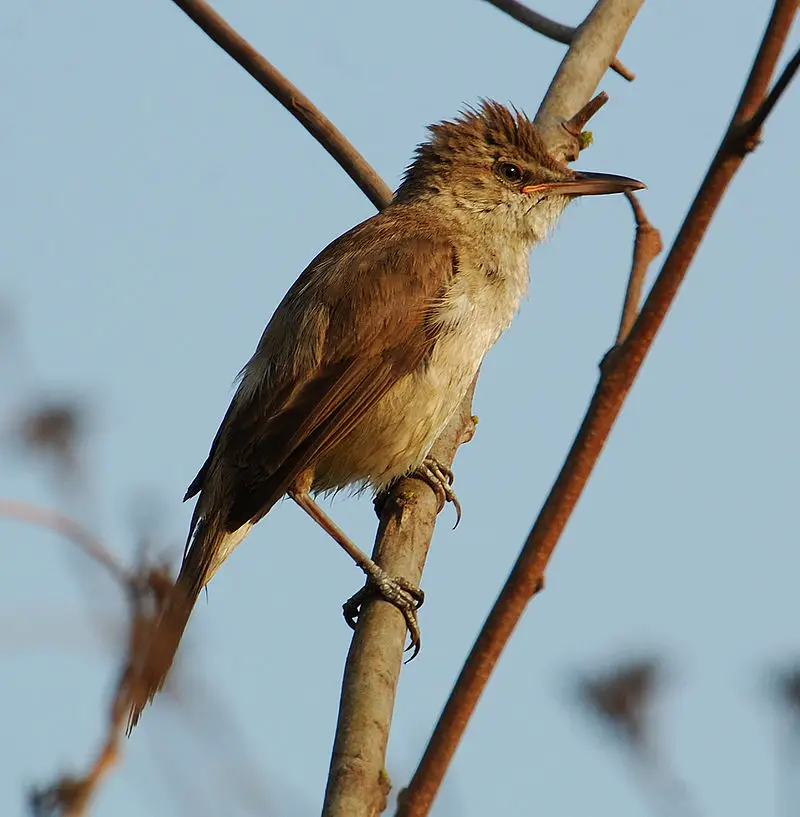
The Clamorous Reed Warbler is a large bird that can grow up to 20cm in length. It is an Old World warbler found in various countries such as Egypt, Afghanistan, India, China, and parts of Southeast Asia.
It has nine recorded subspecies and the A. s. meridionalis is only found in Sri Lanka.
The Clamorous Reed Warbler is often mistaken for a Song Thrush due to its size. It has an unstated appearance, with brownish upperparts and a pale underside.
It is known for its loud and continuous song that can be heard throughout its habitat, which is typically in reed beds near water.
Despite its noisy nature, it can be difficult to spot, as it spends most of its time hidden among the reeds.Scientific classification:
| Kingdom | Animalia |
| Phylum | Chordata |
| Class | Aves |
| Order | Passeriformes |
| Family | Acrocephalidae |
| Genus | Acrocephalus |
| Species | A. stentoreus |
25. Red-Naped Ibis
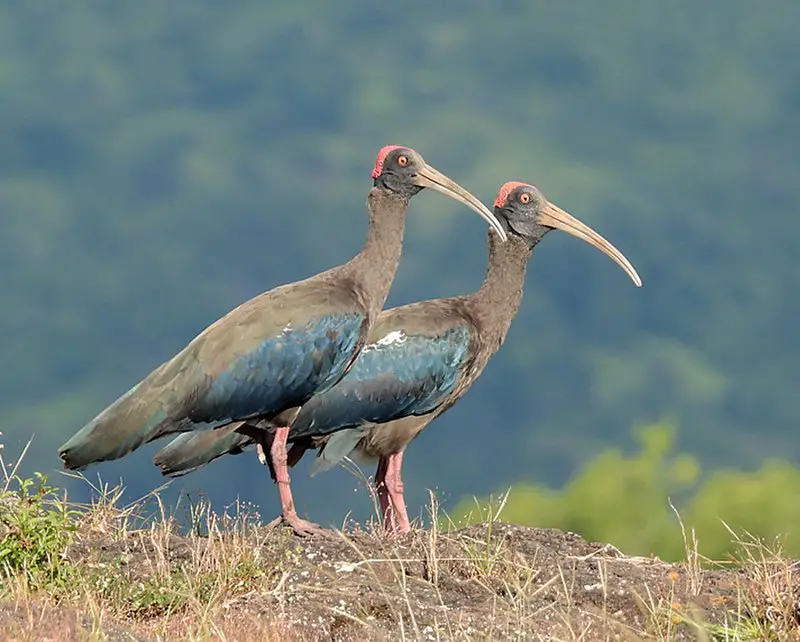
The Red-naped ibis, also known as the Indian black ibis or black ibis, is a species of bird found in the plains of the Indian Subcontinent.
This ibis is unique as it does not heavily rely on water and is often seen in dry fields far away from water bodies.
It is typically found in loose groups and is easily identifiable by its dark body with a white patch on the neck.
The Red-naped ibis, unlike other ibises in the region, can adapt to different environments and feed on a variety of prey. They are known to feed on insects, small reptiles, and even small birds.
This bird species plays an important role in controlling insect populations and is integral to its ecosystem.
Population numbers for the Red-naped ibis remain stable, making it a common sight for bird enthusiasts in the Indian Subcontinent.Scientific classification:
| Kingdom | Animalia |
| Phylum | Chordata |
| Class | Aves |
| Order | Pelecaniformes |
| Family | Threskiornithidae |
| Genus | Pseudibis |
| Species | P. papillosa |
Also Featured In: Birds of Karnataka, Birds You’ll Find in Kanha National Park
26. Tickell’s Blue Flycatcher
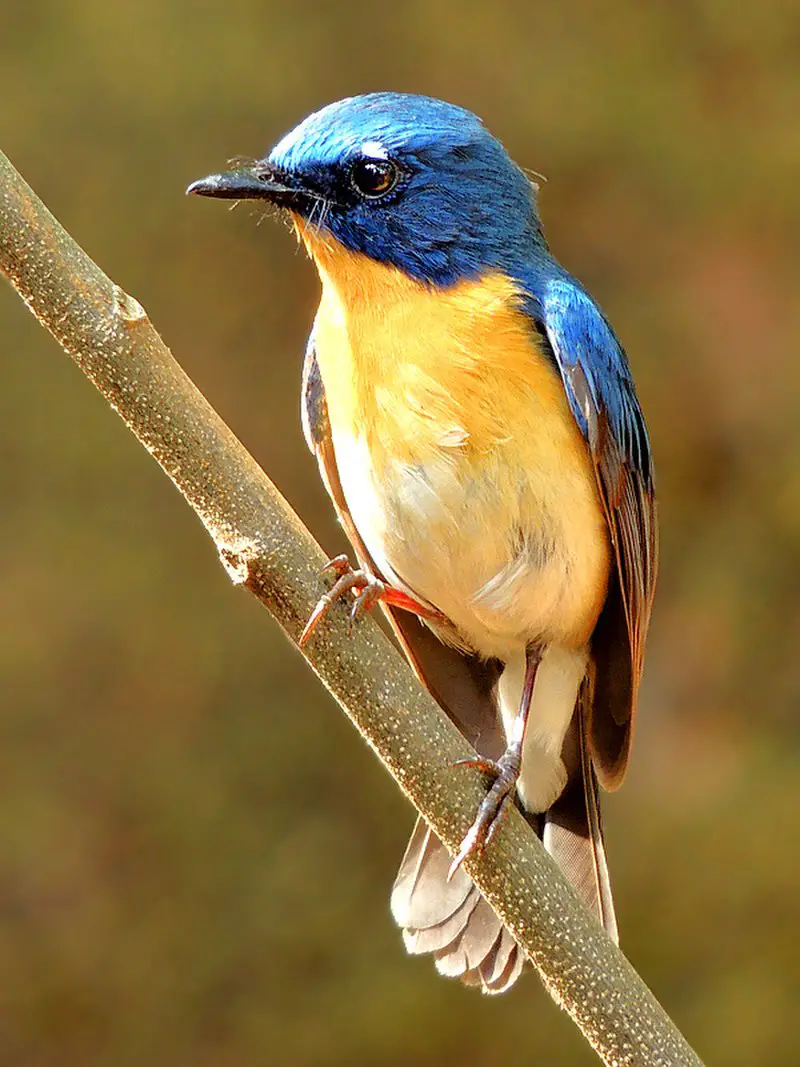
Tickell’s blue flycatcher is a small insectivorous bird that belongs to the flycatcher family. It can be found in tropical Asia, from western Myanmar to the Indian subcontinent and Bangladesh.
The upperparts are blue while the throat and breast have a rufous color. This bird feeds mainly on insects and prefers to dwell in dense areas.
It is a unique species and was once considered as a conspecific of the Indochinese blue flycatcher.
Tickell’s blue flycatcher offers a beautiful sight with its blue and rufous coloration. It can be a challenge to spot them in their natural habitat as they tend to camouflage well in their surroundings.
Overall, this little bird is a charming creature that adds color and grace to the biodiversity of the region.Scientific classification:
| Kingdom | Animalia |
| Phylum | Chordata |
| Class | Aves |
| Order | Passeriformes |
| Family | Muscicapidae |
| Genus | Cyornis |
| Species | C. tickelliae |
Also Featured In: Common Birds of Jharkhand,
27. Ultramarine Flycatcher
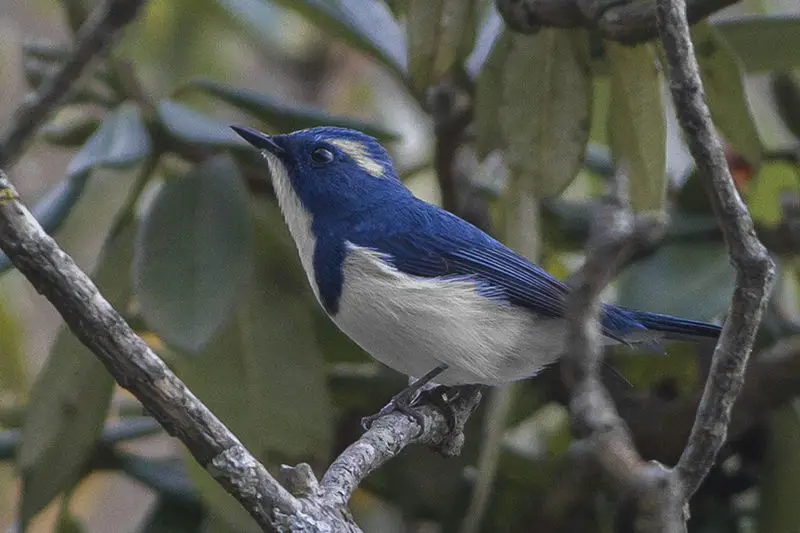
The Ultramarine flycatcher, also known as the white-browed blue flycatcher, is a small bird found in the foothills of the Himalayas. They are smaller than sparrows and have a stocky build.
The male birds are a vibrant shade of deep blue, with a prominent white patch on their forehead. They are arboreal, meaning they live in trees and are part of the Old World flycatcher family.
During the winter months, they migrate to southern India. Due to their bright colors and small size, they can be difficult to spot in their natural habitat.
These birds are known for their ability to catch insects in mid-air, making them excellent hunters.
Overall, the Ultramarine Flycatcher is a fascinating bird that contributes to the biodiversity of the region it inhabits.Scientific classification:
| Kingdom | Animalia |
| Phylum | Chordata |
| Class | Aves |
| Order | Passeriformes |
| Family | Muscicapidae |
| Genus | Ficedula |
| Species | F. superciliaris |
28. Plain Prinia
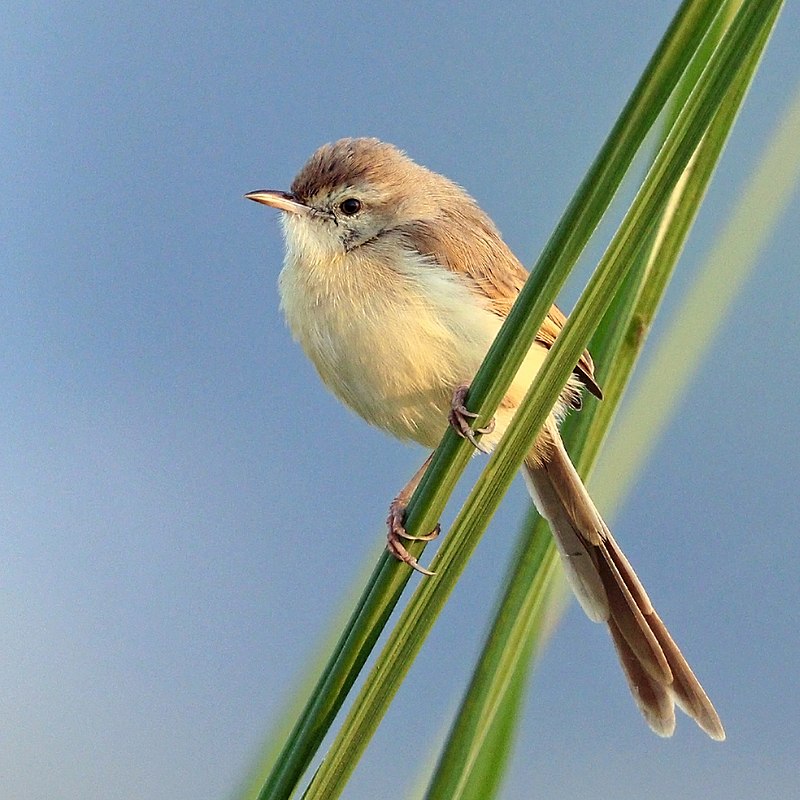
The Plain prinia, also known as the plain wren-warbler or white-browed wren-warbler, is a small bird species found in southeast Asia.
They are resident breeders in regions ranging from Pakistan and India to south China and southeast Asia.
This bird was once considered a part of the tawny-flanked prinia species, which resides in Africa south of the Sahara.
Additionally, the Plain prinia is a cisticolid warbler. This species is relatively small in size and known for its plain appearance.
Despite being widespread, the Plain prinia is not commonly seen since they prefer to stay hidden in dense vegetation, particularly grasslands and shrublands.
The male birds are known for their high-pitched and melodious songs, which they use to attract mates and defend their territory.Scientific classification:
| Kingdom | Animalia |
| Phylum | Chordata |
| Class | Aves |
| Order | Passeriformes |
| Family | Cisticolidae |
| Genus | Prinia |
| Species | P. inornata |
Also Featured In: Common Birds of Chhattisgarh,
29. Streak-Throated Swallow
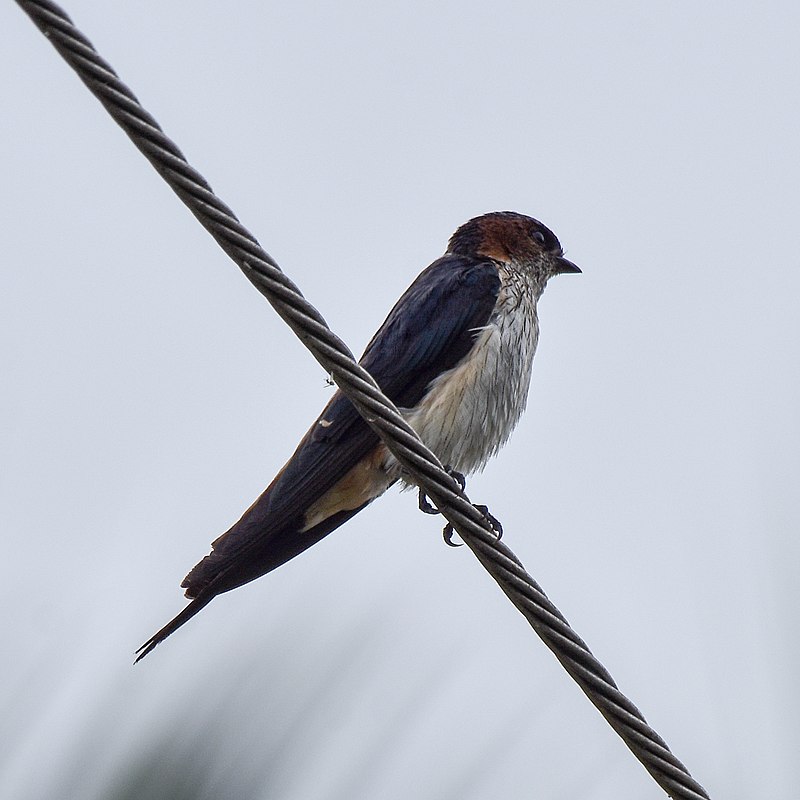
The streak-throated swallow, also known as the Indian cliff swallow, is a bird species that belongs to the passerine family.
It is primarily found in South Asia and can be seen in countries like Afghanistan, India, Nepal, and Pakistan.
This bird species can be a breeder, a year-round resident, or a winter visitor in these regions.
Additionally, streak-throated swallows may also appear as a vagrant in the Maldives, Sri Lanka, and the Middle East.
This bird species is part of a bigger family of swallows and has unique streaks on its throat.
Due to its presence in multiple countries, the streak-throated swallow is an important part of the ecosystem in South Asia.Scientific classification:
| Kingdom | Animalia |
| Phylum | Chordata |
| Class | Aves |
| Order | Passeriformes |
| Family | Hirundinidae |
| Genus | Petrochelidon |
| Species | P. luvicola |
30. Ashy-Crowned Sparrow-Lark
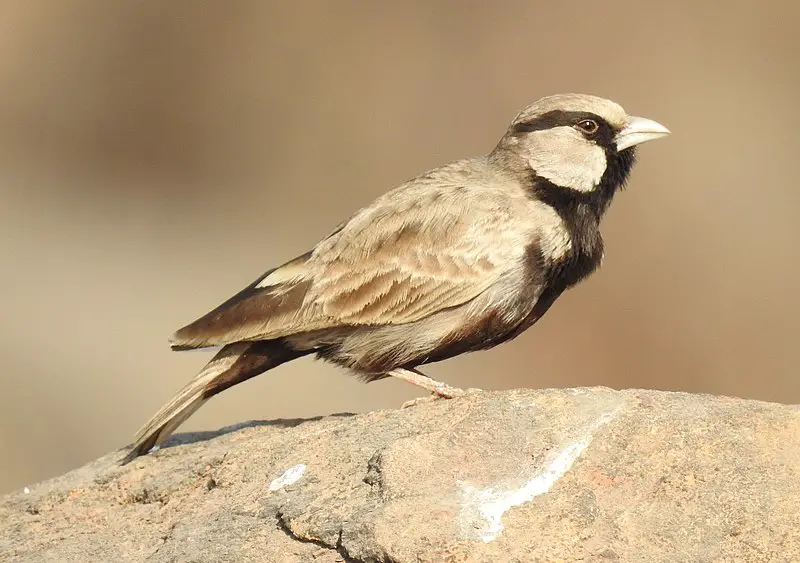
The Ashy-crowned sparrow-lark is a small bird that belongs to the lark family. It is commonly found in open lands across South Asia where there is bare ground, grass, and scrub.
During the breeding season, males are easily recognizable by their distinct black-and-white face pattern, while females have a sandy brown color that resembles a female sparrow.
Despite their small size, these birds are very active and can be seen flying and hopping around frequently.
They are known for their beautiful singing voice, which is often heard during the mating season.
The Ashy-crowned sparrow-lark is an important part of the natural ecosystem and plays a crucial role in maintaining the balance of the food chain.Scientific classification:
| Kingdom | Animalia |
| Phylum | Chordata |
| Class | Aves |
| Order | Passeriformes |
| Family | Alaudidae |
| Genus | Eremopterix |
| Species | E. griseus |
Also Featured In: Most Common Madhya Pradesh Birds,
31. River Tern
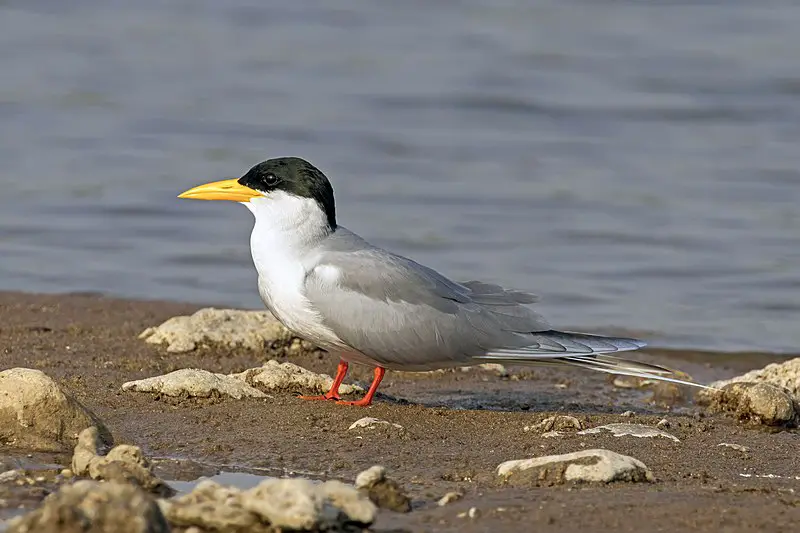
The River tern bird, scientifically known as Sterna aurantia, is a member of the Laridae family. It resides along inland rivers in the Indian Subcontinent, Iran, and eastern Myanmar to Thailand.
This bird is uncommon in Thailand. It is known for living almost exclusively in freshwater, contrary to other species in the same family.
Usually quiet when away from breeding grounds, River terns become vocal during their breeding period, which ranges from March to May.
The River terns build their nests in colonies.Scientific classification:
| Kingdom | Animalia |
| Phylum | Chordata |
| Class | Aves |
| Order | Charadriiformes |
| Family | Laridae |
| Genus | Sterna |
| Species | S. aurantia |
Also Featured In: Common Birds that Live in Odisha, Common Birds of Maharashtra
32. Brown Rock Chat
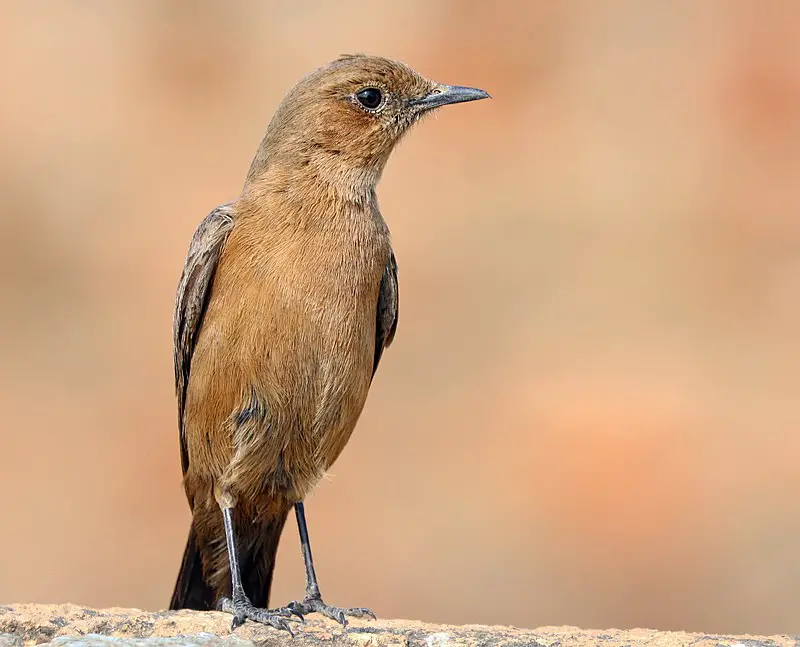
The Brown rock chat, also known as the Indian chat, belongs to the family Muscicapidae and is found in northern and central India. This bird species is commonly found on old buildings and rocky areas.
Despite resembling a female Indian robin, it is larger in size and lacks a reddish vent. Its behavior and posture also differ from the Indian robin. When in flight, it shares some resemblance with thrushes and redstarts.
The Brown rock chat feeds on…Scientific classification:
| Kingdom | Animalia |
| Phylum | Chordata |
| Class | Aves |
| Order | Passeriformes |
| Family | Muscicapidae |
| Genus | Oenanthe |
| Species | O. fusca |
Also Featured In: Birds that Live in Uttar Pradesh,
33. Small Minivet
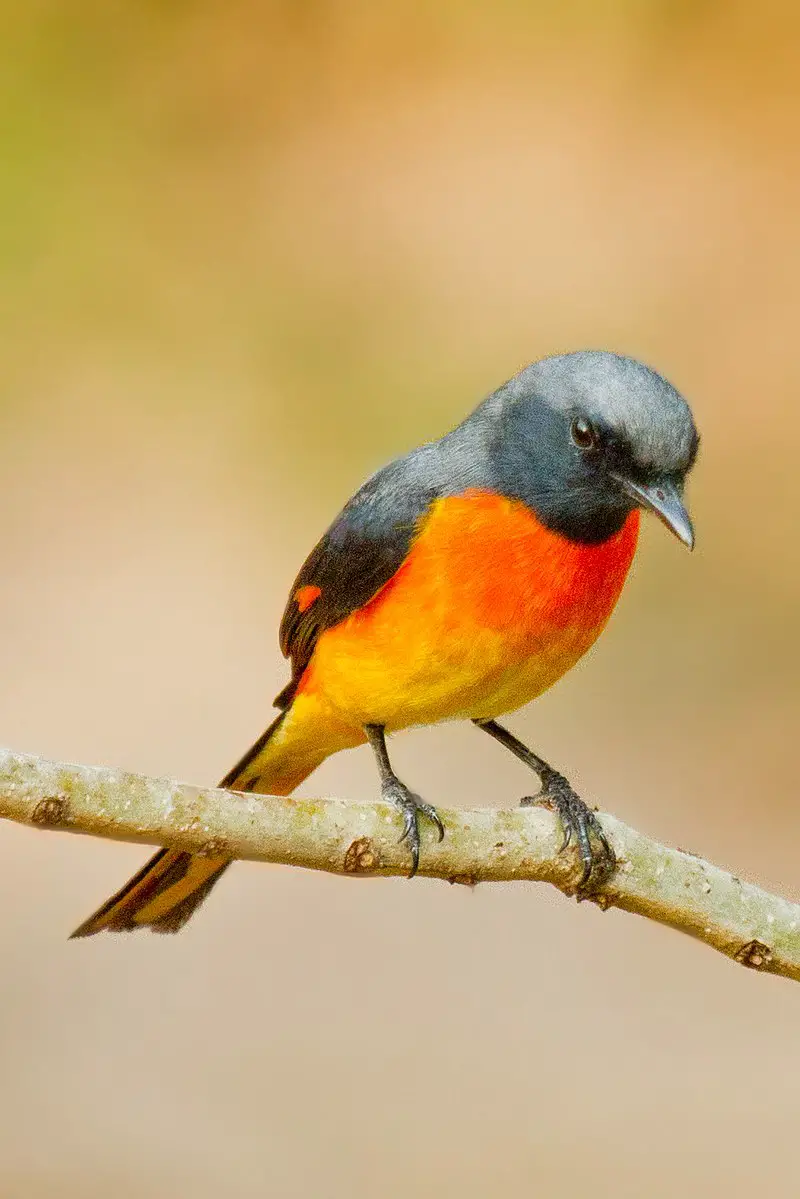
The small minivet bird is a passerine species found in tropical southern Asia. It measures around 16cm in length with a robust dark beak and long wings.
Male small minivets differ from other common minivet species by having grey upperparts and head, and orange underparts that fade to yellow on the belly. This bird can be commonly found from the Indian subcontinent to Indonesia.
Even though the small minivet is a small bird, it is quite remarkable with its distinct features and colorful plumage. Its strong beak helps build intricate nests used to raise their young ones.
Despite its small size, the small minivet plays an essential role in maintaining the ecological balance of their habitat.
Overall, the small minivet is a fascinating species and an excellent example of the diverse and beautiful avian life found in Asia.Scientific classification:
| Kingdom | Animalia |
| Phylum | Chordata |
| Class | Aves |
| Order | Passeriformes |
| Family | Campephagidae |
| Genus | Pericrocotus |
| Species | P. cinnamomeus |
Also Featured In: Birds that Commonly Found in Andhra Pradesh,
34. Sulphur-Bellied Warbler
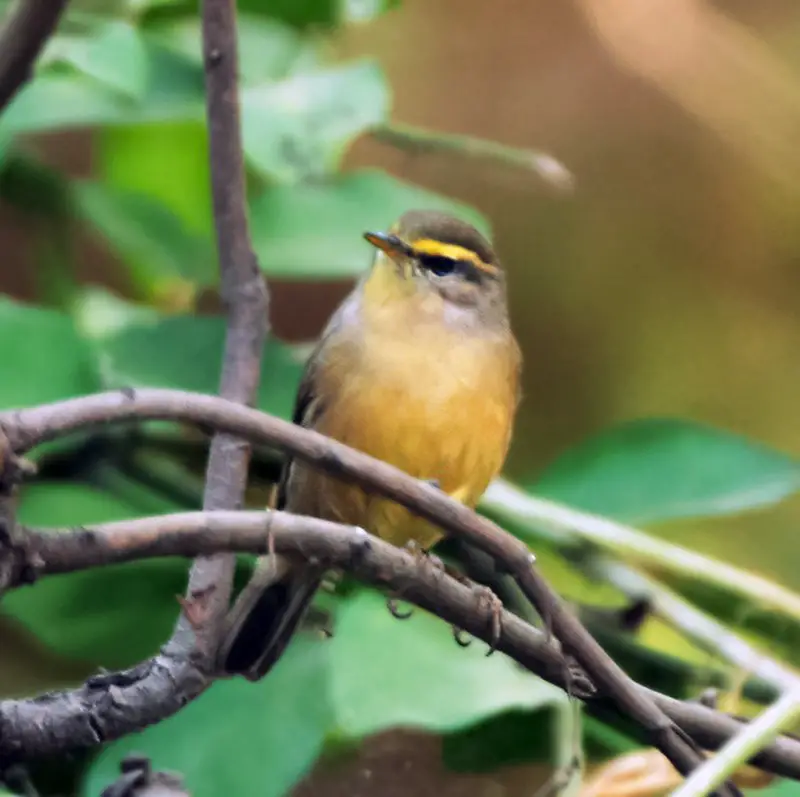
The sulphur-bellied warbler, also known as the olivaceous leaf-warbler, is a small bird found in the Palearctic region. It is commonly seen in Afghanistan, Kazakhstan, Kyrgyzstan, Mongolia, Russian Federation, Tajikistan, and Turkmenistan.
This species of leaf-warbler feeds on insects and can be found in rocky hillsides. It is known for its distinctive yellow underbelly and brownish-green feathers. Like other leaf-warblers, it feeds by gleaning small branches and leaves.
Despite its small size, the sulphur-bellied warbler is an essential part of the ecosystem and plays an important role in the food chain.
Conservation efforts must be made to protect this beautiful and unique bird.Scientific classification:
| Kingdom | Animalia |
| Phylum | Chordata |
| Class | Aves |
| Order | Passeriformes |
| Family | Phylloscopidae |
| Genus | Phylloscopus |
| Species | P. griseolus |
Also Featured In: Birds of Ladakh,
35. Rufous-Tailed Lark
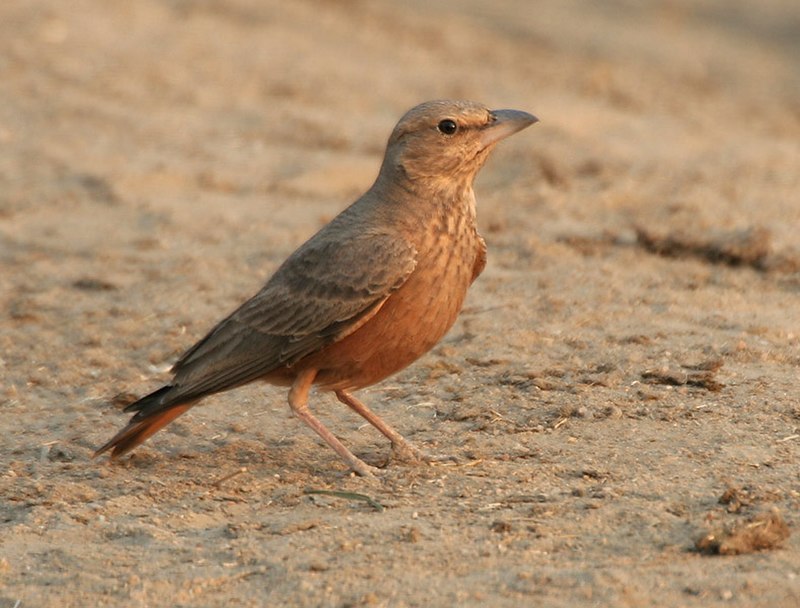
The Rufous-tailed lark, also known as the Rufous-tailed finch-lark, is a ground bird commonly seen in India and parts of Pakistan.
Its large, sturdy bill somewhat resembles that of a finch, with its upper mandible slightly curved.
This bird is typically seen in dry and stony landscapes, foraging for food such as grass seeds, grain, and insects.
With its dull brown coloring, it easily blends in with its surroundings. Both males and females share the same appearance.
Overall, the Rufous-tailed lark’s natural habitat and diet make it a hardy and adaptable bird species.Scientific classification:
| Kingdom | Animalia |
| Phylum | Chordata |
| Class | Aves |
| Order | Passeriformes |
| Family | Alaudidae |
| Genus | Ammomanes |
| Species | A. phoenicura |
36. Black-Breasted Weaver
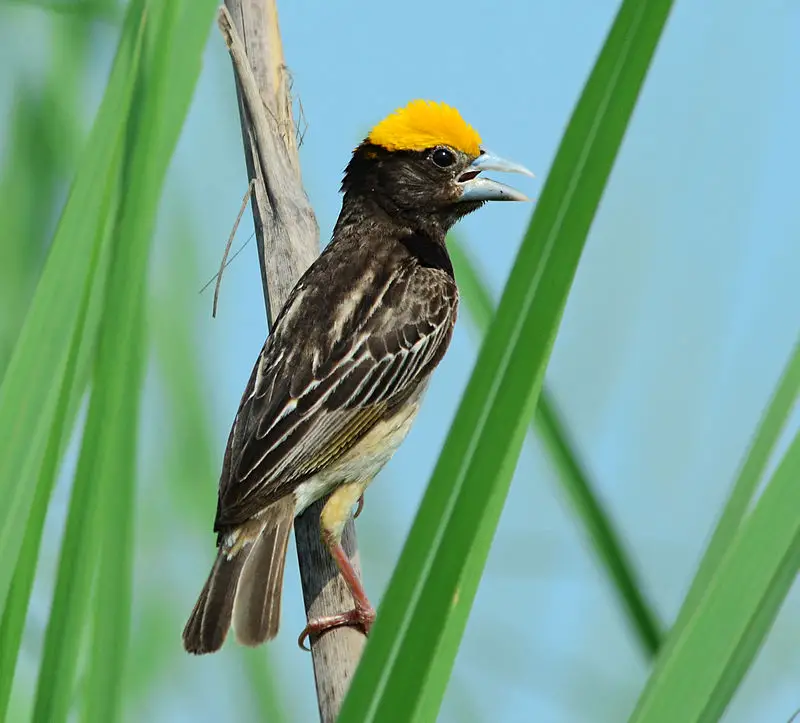
The black-breasted weaver, also called the Bengal weaver or black-throated weaver, is indigenous to South Asia’s northern river plains.
This species builds enclosed nests made of mud and reeds, and female birds select a mating partner based partially on the nest’s quality.
Located in South Asia, this bird is either resident or a local migrant. Males of this species participate in nest-building while females choose mates according to nest quality.Scientific classification:
| Kingdom | Animalia |
| Phylum | Chordata |
| Class | Aves |
| Order | Passeriformes |
| Family | Ploceidae |
| Genus | Ploceus |
| Species | P. benghalensis |
37. White-Browed Fantail
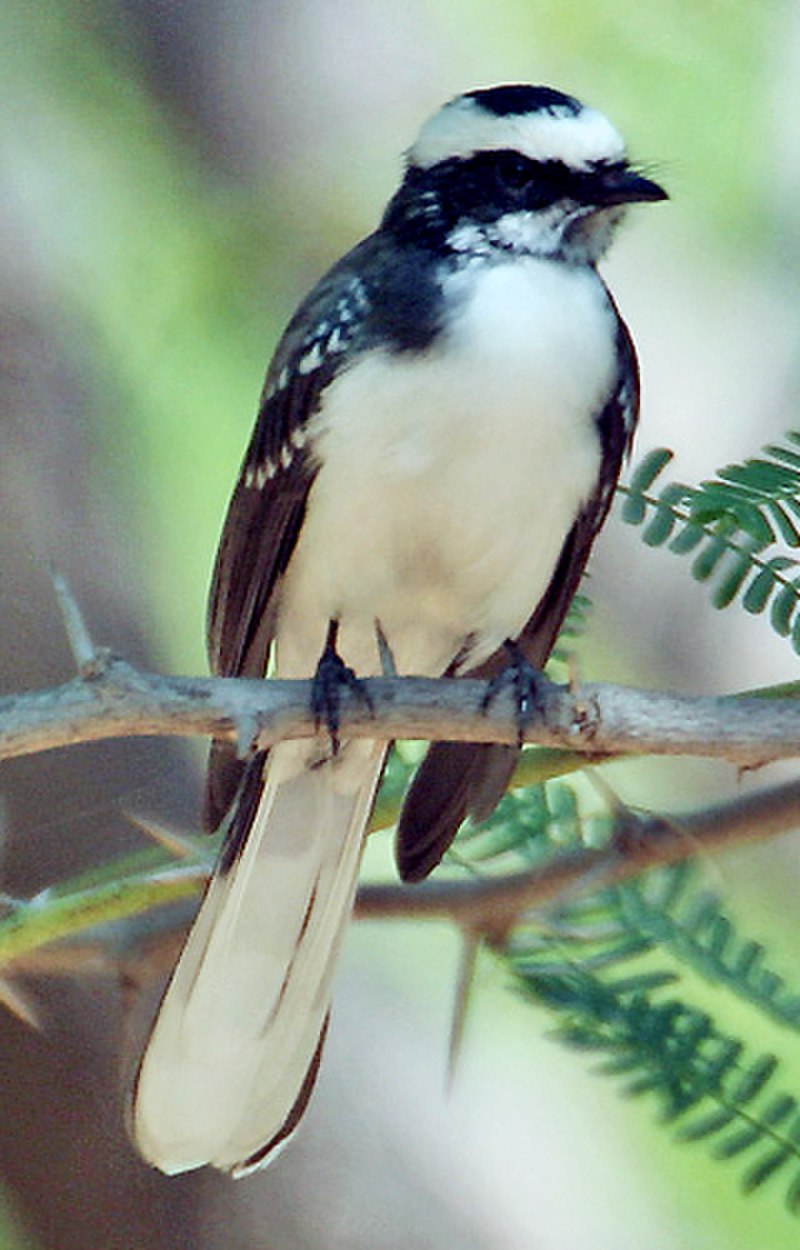
The White-browed fantail bird is a member of the Rhipiduridae family and is quite small, measuring only 18 cm in length. Its upperparts are dark brown, and it has white spots on its wings.
The underparts are whitish, and the tail is fan-shaped and has white edges. On its forehead, the long white supercilia meet, and the throat and eyemask are blackish and bordered with a whitish moustache.
This bird’s appearance is unique, and it is a delight to see in nature.Scientific classification:
| Kingdom | Animalia |
| Phylum | Chordata |
| Class | Aves |
| Order | Passeriformes |
| Family | Rhipiduridae |
| Genus | Rhipidura |
| Species | R. aureola |
38. White-Bellied Drongo
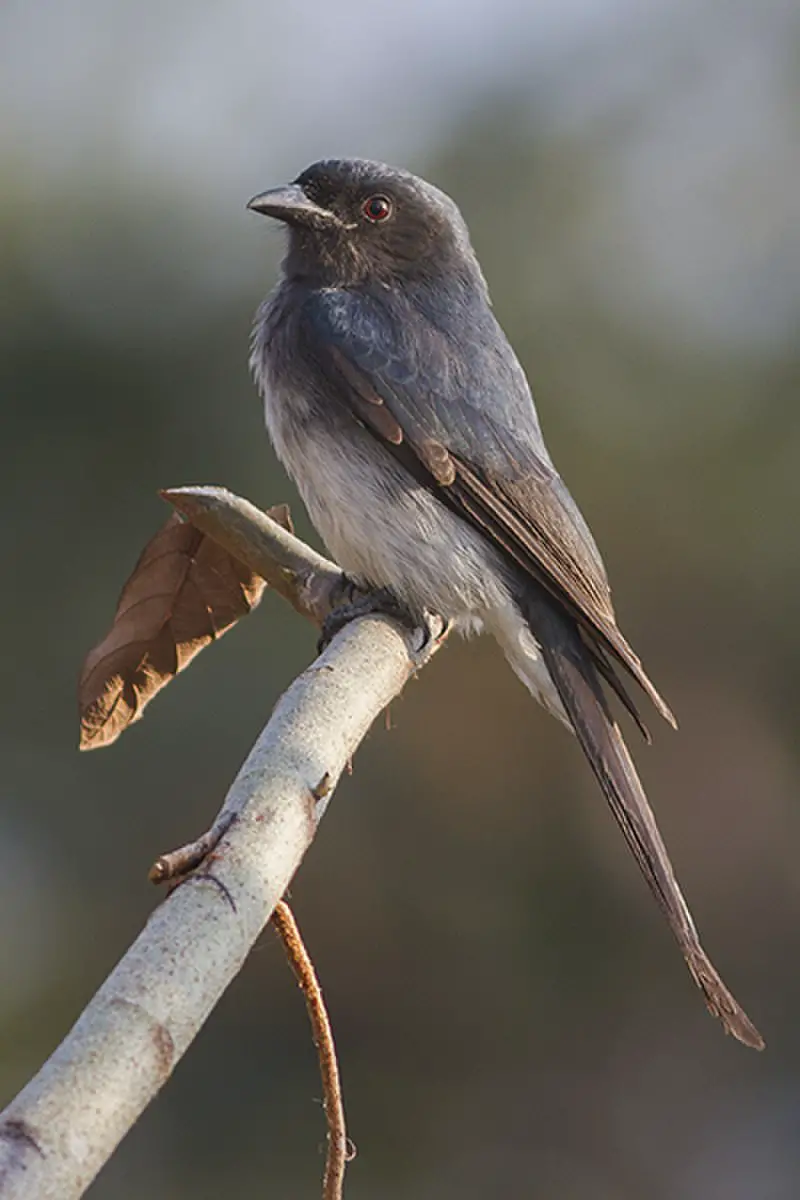
The white-bellied drongo bird is native to the Indian Subcontinent and belongs to a family of insect-eating birds called Dicruridae.
It is mostly black in color with a white belly and vent, but its young ones are completely black and can be easily confused with the black drongo, which is smaller in size.
The bird is often seen hopping around in trees and bushes, hunting for insects to feed on. It has a distinct, chattering call that can be heard from a distance.
The white-bellied drongo is relatively common and enjoys a wide range of habitats, from forests to open fields.
It is an important part of the ecosystem, controlling insect populations and participating in seed dispersal.
Despite being a commonly found species, it is still a beautiful and intriguing bird to spot in the wild.Scientific classification:
| Kingdom | Animalia |
| Phylum | Chordata |
| Class | Aves |
| Order | Passeriformes |
| Family | Dicruridae |
| Genus | Dicrurus |
| Species | D. caerulescens |
Also Featured In: Endemic Sri Lanka Birds,
39. Rufous-Fronted Prinia
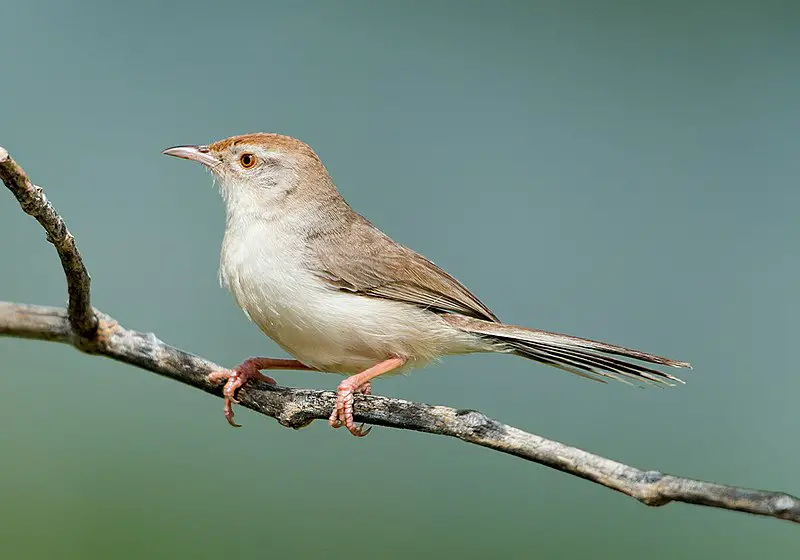
The Rufous-fronted Prinia is a small bird found in India and Pakistan. It belongs to the family of Cisticolidae and prefers subtropical or tropical dry forests.
The species is 12 cm long and is known for its stocky build. The bird was described by Edward Blyth based on an illustration by Buchanan Hamilton.Scientific classification:
| Kingdom | Animalia |
| Phylum | Chordata |
| Class | Aves |
| Order | Passeriformes |
| Family | Cisticolidae |
| Genus | Prinia |
| Species | P. buchanani |
40. Tawny-Bellied Babbler
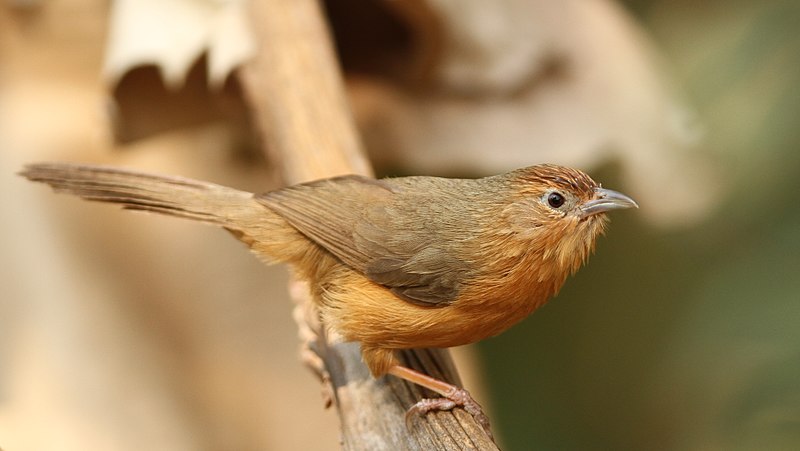
The tawny-bellied babbler is a small bird that lives in low scrub forests. They forage in small groups with other babblers. This bird has soft, fluffy plumage like other babblers.
There are three subspecies found in the Indian Subcontinent, the nominate hyperythra is located in northern areas. The bird is also known as the rufous-bellied babbler in older Indian works.Scientific classification:
| Kingdom | Animalia |
| Phylum | Chordata |
| Class | Aves |
| Order | Passeriformes |
| Family | Timaliidae |
| Genus | Dumetia |
| Species | D. hyperythra |